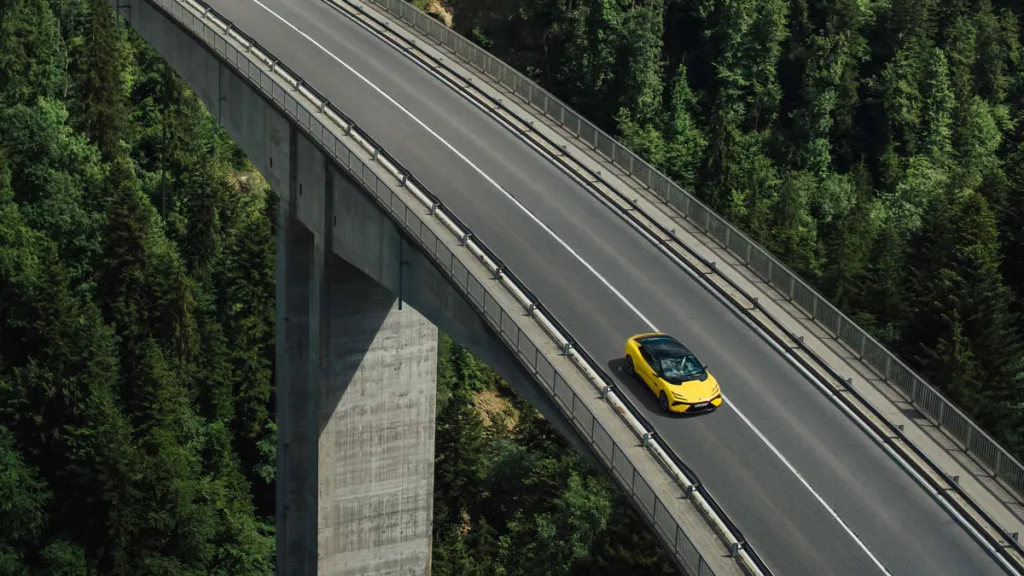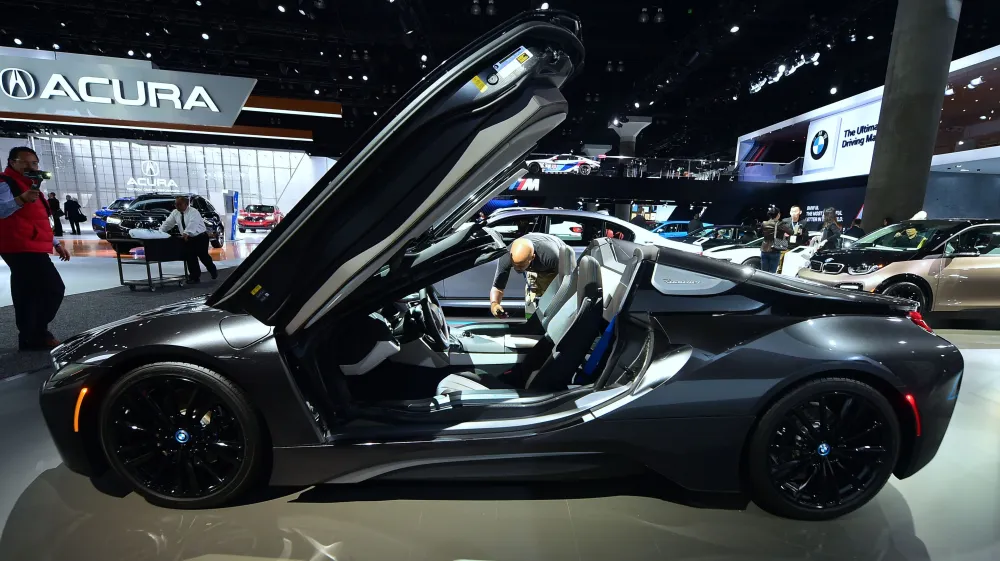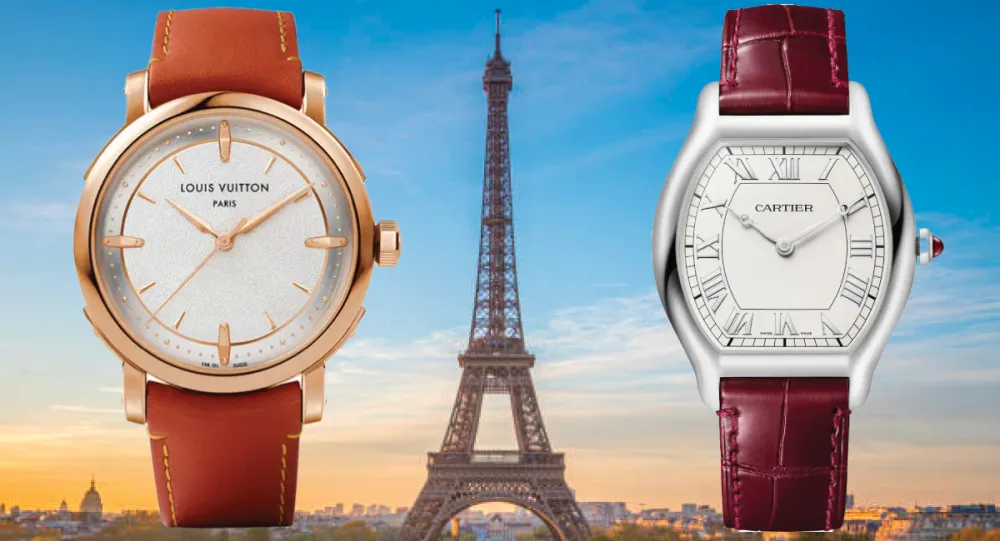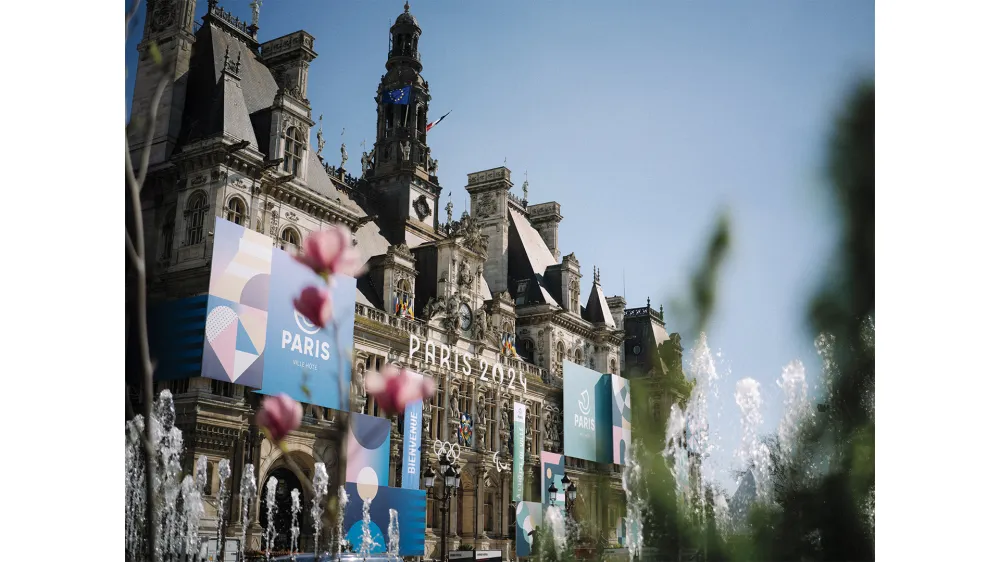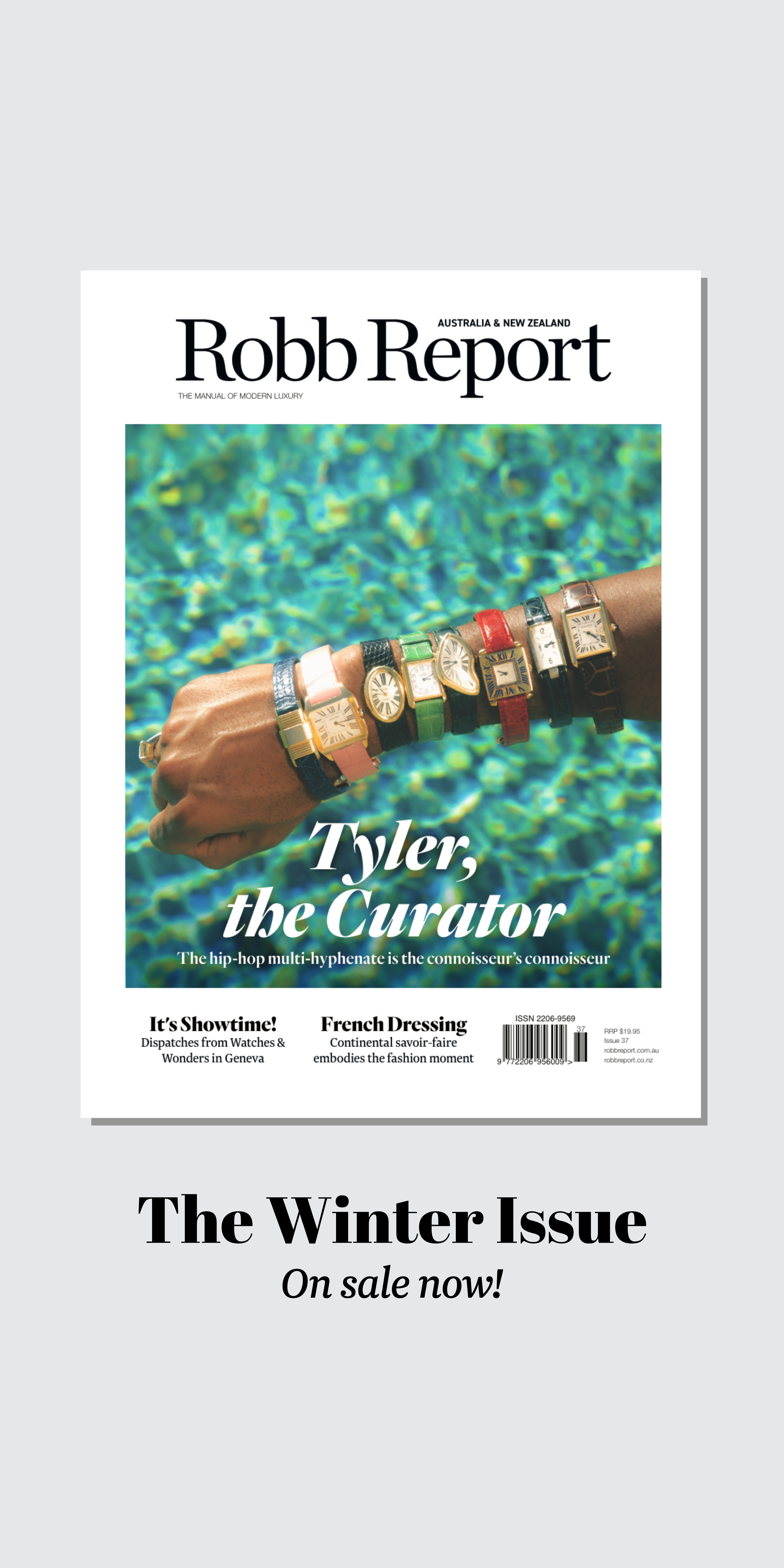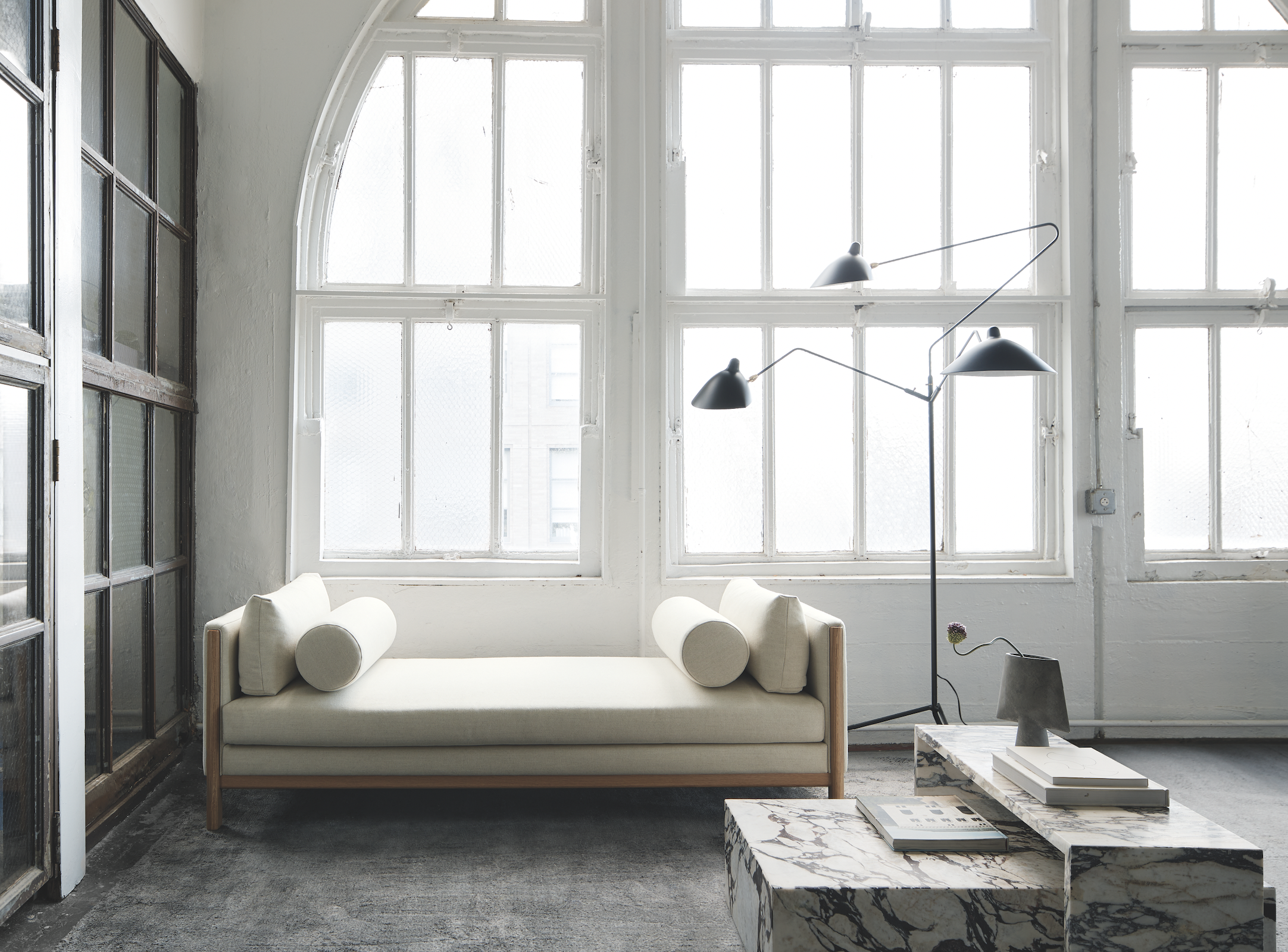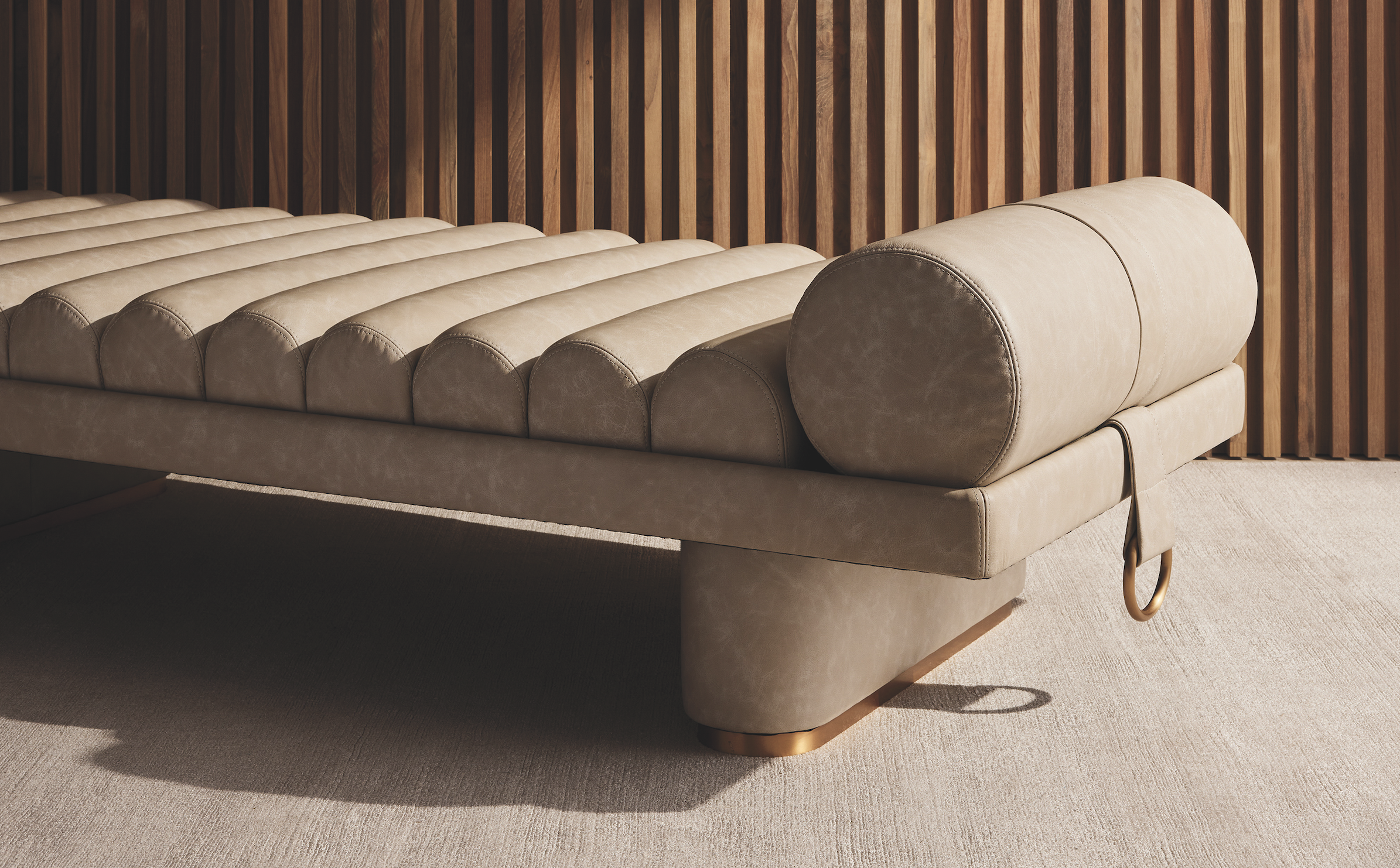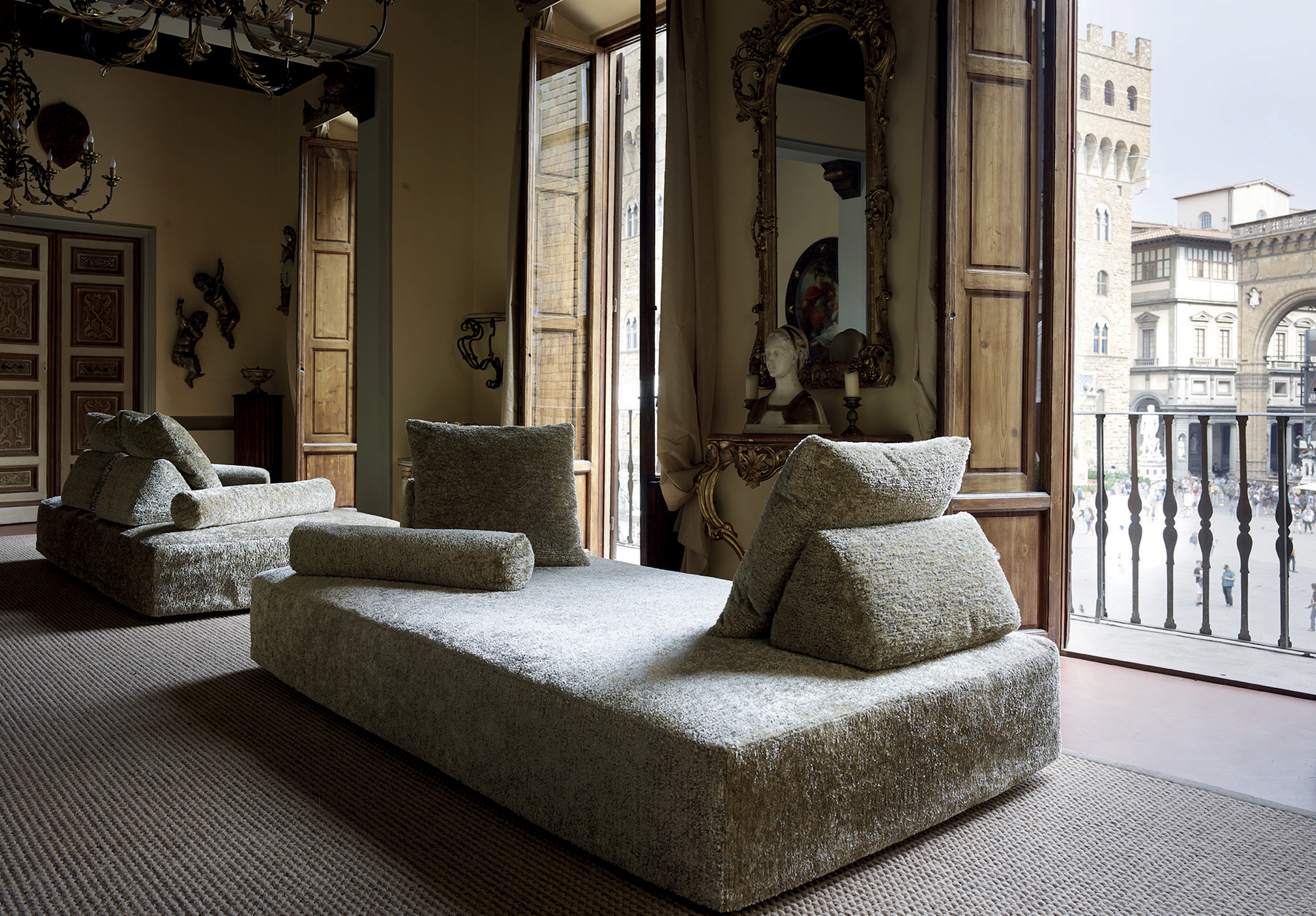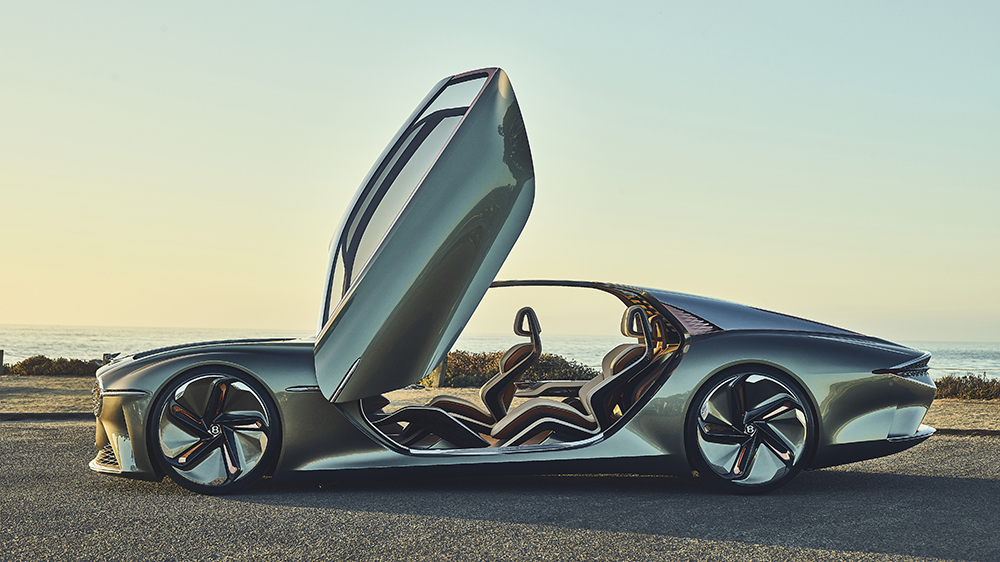
The Smart, Quiet, Utterly Bizarre Future Of The Luxury Car
Artificial intelligence and fast, cheap algorithmic design will transform the automobile—and it will only get weirder from there.
Related articles
For as long as anyone could remember, a car was a car was a car. And then, one day, it wasn’t.
Which is to say the notion of an automobile going back a hundred years—a multi-box design on four tires, with a wheel and pedals, aimed by people and powered by orderly little explosions—has been upended by a maelstrom of globalisation, technological revolution, environmental reckoning and a wholesale assault on the ownership model. Such extreme disruption has unleashed a rapid evolution of the automotive species, with strange creatures now roaming the roads: Rolls-Royce SUVs and silent, battery-powered Croatian hyper-cars; Cybertrucks and fin-shaped hatchbacks with gullwings and brains big enough to take the wheel for a spell. It’s like looking around one day and realizing some dogs are now the size of horses and chirp, while others have opposable thumbs, sonar and definite opinions on Brexit.
Take the luxury car. Not long ago the term meant something fairly specific: a large, imperious saloon with a respectably immoderate gas-burning engine and a leathered and carpeted backseat with ample space for raising a family. Now it’s as formless and atomised as the rest of the sprawling luxury universe, which includes collectible sneakers and stiff, terrifying plastic Japanese teddy bears and feeling very ashamed of your jet. Tesla’s austere, vegan-friendly robots are the must-have choice for the Silicon Valley set even as six-figure SUVs proliferate like 2000kg bunnies in the exurbs. Meanwhile, a younger generation of buyers appreciates zero-emissions vehicles but would really rather the automobile had the good sense to go away entirely, like voice mail.
Yet there are signs the automotive industry is finally coalescing around an idea of what a car will be in the future—and down that road lies an interesting potential detour: The luxury car, instead of simply representing a pricier version of whatever the car du jour is, branches off into something else entirely. For the first time ever, a difference not just of degree but of kind, transformed by three interconnected forces: artificial intelligence, the rise of niche manufacturing and increasing rarity.

New technology will create streamlined cockpits, like in Aston Martin’s Lagonda All-Terrain Concept. Courtesy of Aston Martin
Artificial Intelligence
Two major technological revolutions are shaping the car of the future: electrification and autonomy.
Electric vehicles (EVs) will eventually win out not simply because of an increased focus on sustainability, or because Tesla made them sexy, but because they provide undeniable benefits for an industry that’s become overwhelmingly consolidated, inextricably globalised and massively regulated—and because EVs ultimately pair better with self-driving technology.
Wide-scale EV adoption not only alleviates regulatory headaches over what’s being spewed from the tailpipe—EVs have no spew, and no tailpipes—but the cars are also simpler to manufacture and suited to the type of modular architecture now favoured by the world’s largest automakers, in which a few platforms underpin a wide variety of vehicles. (The Volkswagen Group, which owns 12 brands across seven countries, produces more than 30 different models on its MQB platform alone, from sports cars to minivans.) Plus, the world’s largest car market, China, is pushing a blistering rate of battery-powered EV adoption—more than a million electric and hybrid-electric cars sold in 2018—with Europe, the third-largest market, attempting to keep pace. Regardless of whether the US intends to continue its retrograde love affair with fossil fuels, an increasingly climate-minded global market will ensure the automobile’s plugged-in future.
As for self-driving technology, it’s anyone’s guess when it becomes a widespread consumer reality; it’s not just a question of technological capability but a complex matrix involving legislation, infrastructure and liability. Meanwhile, everyone from Samsung to Uber is spending astonishing amounts of money to ensure a front-row seat whenever the show starts.
“Without a doubt, on our road map is to have privately owned vehicles enabled with our technology,” says Adam Frost, chief automotive and corporate development officer at Waymo, formerly the Google Self-Driving Car Project, now its own entity within Google’s parent company, Alphabet. “And our partners are obviously very interested in that. We’re in discussions with them around, ‘What is that product?’”

Rolls-Royce says its 103EX Concept will be “as unique as your own fingerprint.” Courtesy of Rolls-Royce
But the day when you can Netflix and chill in your Level 4 autonomous ride is years, if not decades, away. For now, companies like Waymo, Cruise and Argo AI have partnered with (or been bought by) automakers to develop fleets of L4-equipped taxis that operate within the confines of certain test cities: Waymo runs autonomous Chrysler Pacifica minivans in parts of Phoenix, while Argo has AI-equipped Fords operating in Palo Alto, Detroit and Pitts- burgh. These vehicles rely on information from onboard hardware such as cameras, sensors, radar and a laser-based system called LIDAR, plus incredibly detailed 3-D maps.
“We make a Waymo-specific map,” Frost says. “It’s a very deep understanding of the physical environment. It uses a high-definition mapping system that understands where hills are. It can see stop signs, it knows where the traffic lights are, where the lane markings are. It even has the curb edge captured.”
According to Alex Roy, a journalist for The Drive who writes frequently about automation and is an investor in the AV space, the industry’s “geofenced” operating areas and automotive-technological partnerships hint at how the technology could roll out for personally owned autonomous vehicles.
“The artificial intelligence stack has to be taught anew in each city,” Roy says. “You start with one city, then you add more cities, and then, eventually, those cities can be connected. It’s service coverage, like a cell-phone map.” At some point, Roy says, AV companies will have to compete for personal-vehicle customers in overlapping markets. That could mean choosing a Ford over an Audi based partly on the brand, specifications and range of its autonomous technology, like choosing a mobile phone based not just on features like screen size and operating system but service area and call quality. A vehicle’s tech capabilities (autonomous and otherwise) will increasingly become distinct vehicle features, like the engine or stereo system, upgradable for those who want the latest and best—and not just the tech itself, but how it’s deployed.

Part of Google’s advanced quantum computer. Courtesy of Google
Consider that, by design, autonomous vehicles are unlikely to ever truly flaunt the speed limit like a human would, no matter how much open road lies ahead. That means, during the period when roads are shared by both human-driven and autonomous machines, getting anywhere faster than the posted limit in an AV might require the opening of a wallet instead of a throttle.
“Luxury cars that have been upgraded in the system as ‘priority vehicles’ could be allowed to travel much faster and overtake nonpriority cars,” Roy says. “For a price.”
And that’s to say nothing of in-cockpit technology. The crazed rush to develop self-driving capability kicked open the auto industry’s door to Big Data. Now comfortably inside, Amazon, Apple and Google have no intention of ceding a massive captive audience—more than 80 million new vehicles were sold worldwide in 2018 alone—that will soon have to figure out what to pay attention to inside a car once driving has been scratched off the list. Ordering the luxury vehicle of the future might entail ticking boxes for gaming and entertainment packages that include the latest Fortnite release and an Amazon Prime video subscription, or a health package with integrated real-time biometric monitoring.
If that sounds far away, that’s because it is. But Big Data is changing the possibilities around the luxury car in more tangible ways, and some of the most incredible are happening right now.
Niche Manufacturing
“To create a vehicle at the moment, whether it’s a run of one or a hundred or a hundred thousand, the investment needed in tooling and man-hours is astronomical,” says Felix Holst, chief product officer and founding partner of Hackrod, a start-up that explores radical new manufacturing applications in the automotive space. “As 3-D printing and robotic metal forming and all sorts of other advanced, automated manufacturing techniques come online, it has the power to put the consumer in touch with manufacturing—in effect, mass manufacturing in the quantity of one.”

The algorithmically generated chassis design for Hackrod’s La Bandita roadster.
This is the bleeding edge of automotive production. Even Tesla’s heavily automated Fremont factory, a vast California facility where whirring robots press and laser and lift car bodies 15 feet onto a rail system with the ease of placing a can of soup on a shelf, relies on an essentially traditional manufacturing process: Designers sketch cars, engineers model and refine the design, and people and machines assemble the parts. But Holst and Hackrod cofounder Mouse McCoy saw that a convergence of advanced technologies—artificial intelligence, virtual reality, algorithmic design, 3-D printing—could flatten the process in the same way that music software like GarageBand turned the labour-intensive process of making an album into something replicable by a bored teenager in his bedroom. Holst, a former vice president for design at Hot Wheels, says the goal was to imagine “whether three kids in their garage could start a car company.”
The result was Hackrod’s La Bandita roadster, built on a chassis conceived not by engineers but by a machine-learning algorithm and brought to life by advanced manufacturing processes.
“It’s generative design,” says Holst. “Which is basically, set your needs and parameters for what you’re trying to achieve and allow cloud processing to give you an optimised structure that solves for those needs.” This type of algorithmic software can already tackle complex engineering problems, such as an engine swap. When staggeringly powerful quantum computers become widely available (as of this writing, there are reportedly only 11 examples online around the world), such calculations could be computed across infinite parallel universes just for fun.
The implications for vehicle customization are astounding, especially in a future of simplified electric vehicles. A customer could buy a modular EV “skateboard”—a flat row of batteries on motorized running gear—then commission a boutique manufacturer to algorithmically generate a body design to exact performance and safety specifications, crash-tested in virtual reality and printed over the course of days or even hours, and entirely unconstrained by needs like a driver’s seat or a windshield you can see out of.
“We build the entire automotive experience around a steering wheel and pedals, so all cars have a similarity to them,” says Frost. “When you think 30 years down the track, and the Waymo [autonomous] driver being an enabler, it becomes a blank sheet.”

Interior of Rolls-Royce concept Courtesy of Rolls-Royce
And creativity need not stop at the vehicle manufacturing. The interior and exterior could be painstakingly hand-finished using a combination of high-tech and old-school techniques, like contemporary resto-modifiers do today with classic cars. That could mean everything from 3-D-printed seats, designed using personalized body mapping and upholstered by hand, to a carbon-fibre rear wing re-created to the exact, laser-scanned dimensions of the ’95 Le Mans–winning McLaren F1 GTR.
“We really are on the cusp of some very dramatic shifts,” says Holst. “There is a view of the future that is very like the golden age of coachbuilding.”
To make such bespoke vehicles self-driving, imagine AI software and sensor hardware bundled together as an off-the-shelf automotive component the same way you can buy a Ford crate engine or parking sensors from Amazon. Waymo already sells its LIDAR scanning tech to nonautomotive customers, while San Diego– based Comma.AI offers a $930 device called the Eon DevKit, which uses a camera and the brand’s open-source software to enhance the driver- assistance systems of numerous vehicles across brands, like an aftermarket Tesla Autopilot.
Such bespoke and well-equipped machines will not come cheap; they will be the wild exceptions among a herd of increasingly homogenized commuter shuttles—until, of course, they’re not. Citing huge demand for mass-market but customisable 3-D-printed gear from Nike and Adidas, Holst suggests such cars “will very quickly be for the everyman.”
And when such dream machines become available to the masses, where will the luxury car go from there?

Tesla’s Cybertruck brings the post-apocalyptic future to the present day. Tesla
Rarity
There is a future––far away and hardly guaranteed, but possible—in which your average car is nothing but a whizzing electric box powered through inductive charging by the very roads on which it expertly drives itself. A luxury version of such a car is easy to imagine: Just make the box bigger and more sumptuous, an autonomous transport the size of a rock band’s touring bus lavishly appointed by the great interior designers of the time, hung with art and plied with every amenity from sleeping quarters and a gym to climate-controlled wine storage.
But in this same obscure tomorrow there’s another version of the luxury car, one which is considered an astonishing oddity to behold—outlandish, anachronistic, perhaps even deliberately provocative. That car will look, nearly exactly, like the car of today: an utterly servile box and tires, with a steering wheel and pedals, powered by the crude liquefied remains of dinosaurs.
The automobile may be rolling toward an electrified, customizable, self-driving future, but technology trends toward the efficient and the democratic—two qualities the luxury market can’t abide. Just consider the story of the “quartz crisis,” which almost killed off the luxury watchmaking industry as we know it.
In the waning days of the 1970s, the entire horological industry decided it had seen the future, and that future ran on batteries. Quartz-powered watches were more accurate, more reliable and far cheaper to produce than complex mechanical movements. Everyone from Rolex to Patek Philippe embraced the brave new world; brands across Switzerland destroyed their watchmaking machinery, the old ways unceremoniously discarded in heaps of suddenly obsolete tooling.

Bentley EXP 100 GT concept car Courtesy of Bentley
Then, eventually, the fever waned. Luxury buyers were no longer enamoured of simplicity and efficiency. They wanted instead to absorb themselves in the complex, inefficient, labour-intensive products of human industry, as they did with their architecture and wines and bespoke suits. Powered once again by intricate mechanical movements, the luxury watchmaking industry eventually regrew itself into a multibillion-dollar industry that shows no signs of slowing.
There is no such mass-market future for the loud, brainless, gas-powered automobile, especially when fossil fuel may cost as much as gold and legislation and liability have driven human-powered cars from the road in the name of safety. And as congestion pricing and subscription-based automotive services conspire to hollow out the middle-class ownership model, “the luxury of private ownership is about to become far more rare, especially in cities,” says Alex Roy, with future roads populated by vehicles paid for “by the minute or mile.”
But for those collectors who can afford to house and feed and maintain a fussy, demanding, extravagant curiosity, the reward will be a direct link to one of humankind’s greatest achievements, a remarkably robust and sometimes dazzling beast of burden on whose back we built the modern world.
One will need more than access to gasoline and a dying breed of knowledgeable mechanics. An archaic automobile kept alive in a distant future will require space to roam. And in a world of whizzing boxes depositing us like pre-sorted mail, what savage freedom it will be to take off toward nowhere and let the thing bellow and fart and run where you tell it, as fast as you dare. They’ll call it senselessly dangerous and heretically backward—the kind of outmoded, mostly illegal fun available only to historical reenactors and the very rich.
Which is to say, according to Roy, “the best way to ensure you’ll be able to drive in the autonomous future is to own the road you’re driving on.”
This story comes from our latest Autumn 2020 issue. To purchase a copy or to sign up to an annual subscription of Robb Report Australia & New Zealand click here. To stay in touch with all the latest news click here.
Subscribe to the Newsletter
Recommended for you
First Drive: The Lotus Emeya Targets Porsche, Mercedes, and Lucid With Its 70 kw Performance
What the all-electric sedan lacks in cohesive styling is more than made up for in muscular athleticism.
By Tim Pitt
July 22, 2024
Why BMW’s First Electric Cars Are Future Classics
Many things still feel contemporary about the BMW i3 and i8.
July 11, 2024
You may also like.
You may also like.
8 Trés Chic French Watches Perfect for Commemorating the Olympics, from Breguet to Cartier
Chanel, Cartier, Louis Vuitton, Breguet, and more make up quite a stellar list of French watches perfect for remembering the Paris Olympics for decades to come.
The opening ceremony for the 2024 Olympic Games takes place in Paris on July 26th. Whether or not you’re attending the games, one way to celebrate the start of the world’s biggest sporting event, and to show some espirit de corps with your fellow Francophiles, is by treating yourself to a French watch. Of course, you could go for the very Swiss Omega Speedmasters that came out to commemorate the Paris Olympics earlier this year, and that would be a tasty choice, but perhaps something more French is in order.
Also, if you’re going to be in Paris for the games (or anytime really) we have an excellent guide to the best watch boutiques in Paris for you, as well.
While not all of the timepieces highlighted below were made in France (so few watches are anymore), they each have deep connections to Paris, French watchmaking and/or Gallic style. And, as we’ve written elsewhere, French watchmaking has a long-standing and powerful influence on Swiss watchmaking. In fact, it was in Paris the Louis Cartier perfected the Tank that would go on to make wearing a watch on the wrist popular in the first place, this during the 1920s and 30s. And, of course, Cartier watches are all the rage these days, including the rather tiny Tank Mini, which made big waves at Watches and Wonders this year, as well as the Tortue, which made our best-of list this year.
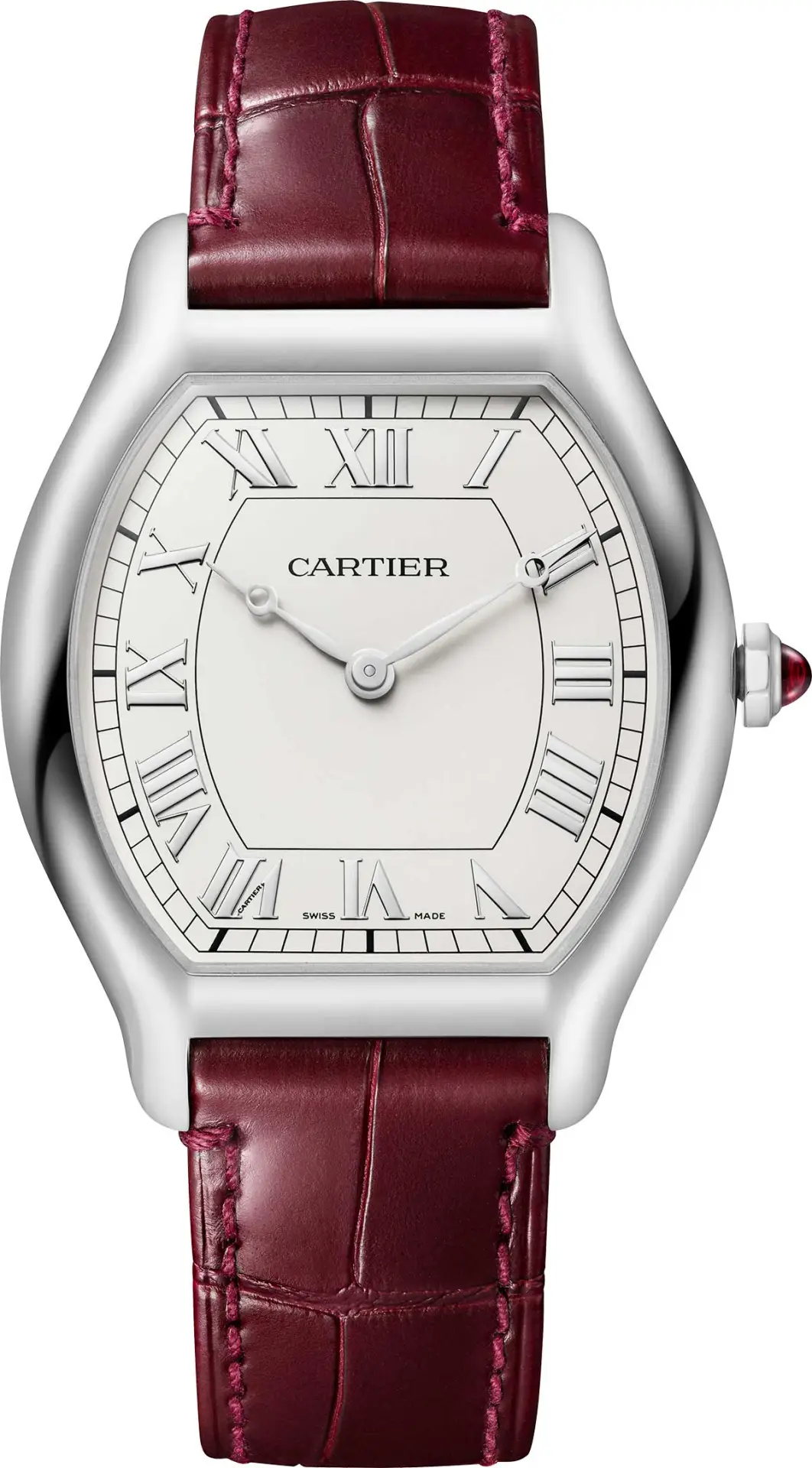
Indeed, the Parisian horological roots run deep, but it’s not all Cartier. From Louis Erard’s whimsical collaboration with French interior-designer-turned-watchmaker Alain Silberstein to the dreamy, avant-garde designs of Paris-based Trilobe, there’s something for everyone in this mix.
Of all the watches Cartier introduced at Watches and Wonders Geneva this year, the Tortue re-edition was the most talked-about. Even older than the Tank, the tortoise-shaped model (born in 1912) is now available in a monopusher chronograph as well as the simpler “hours and minutes” platinum version shown here. Limited to 200 pieces, the stylish and shapely Tortue, which comes out in September, makes clear that even though Cartier manufactures all of its watches in Switzerland, the Paris-based brand is French to its core. $54,770.
Breguet Classique Double Tourbillon “Quai de l’Horloge” 5345
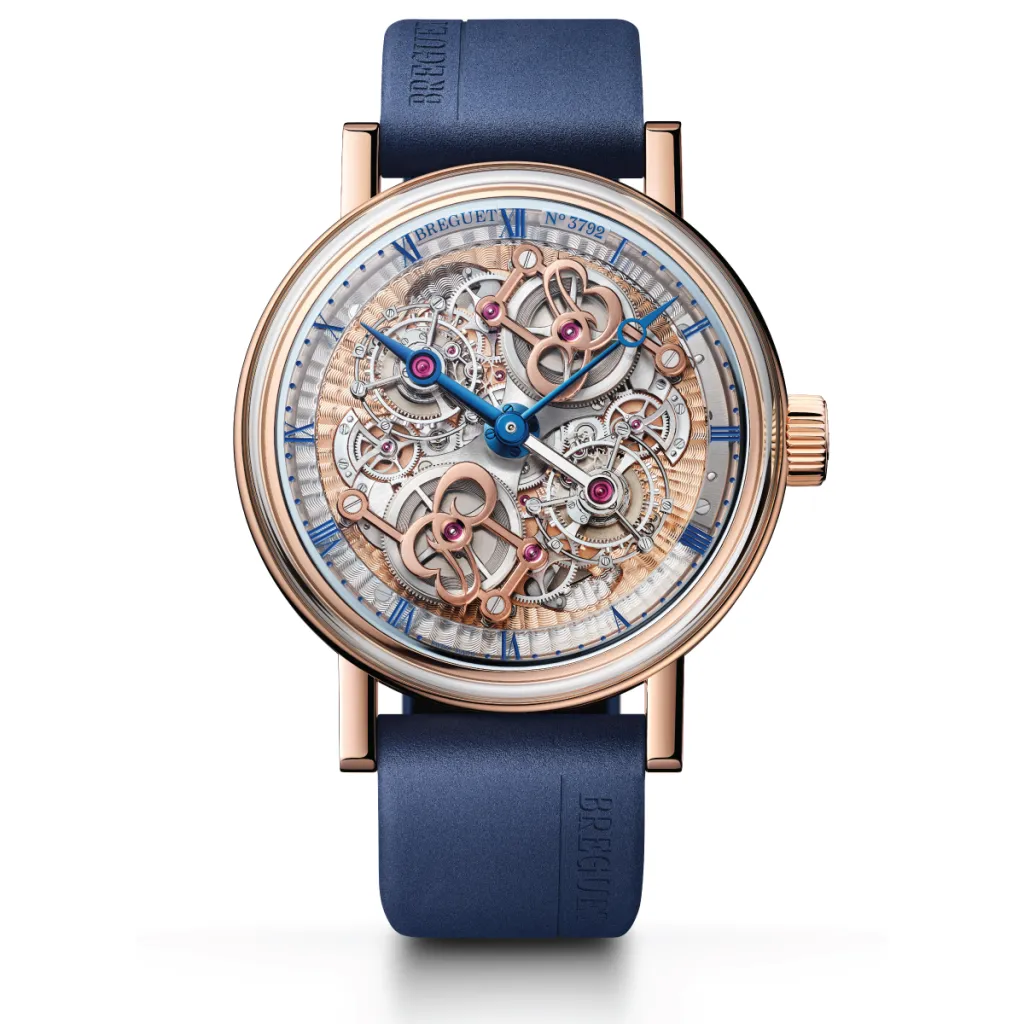
Although Breguet is now based in Switzerland, its namesake, Abraham-Louis Breguet, inventor of the tourbillon as well as the now-ubiquituous Breguet hands and numerals, made his mark on horology in Paris, where he maintained a workshop at 39 Quai de l’Horloge. The brand pays tribute to that history with its latest tourbillon, a 46 mm rose gold wristwatch equipped with not one, but two of the whirling mechanisms. Be sure to admire the engraving on the back of the movement, which depicts an aerial view of the workshop. C’est magnifique! Price on request.
Trilobe Les Matinaux L’Heure Exquise Dune Edition
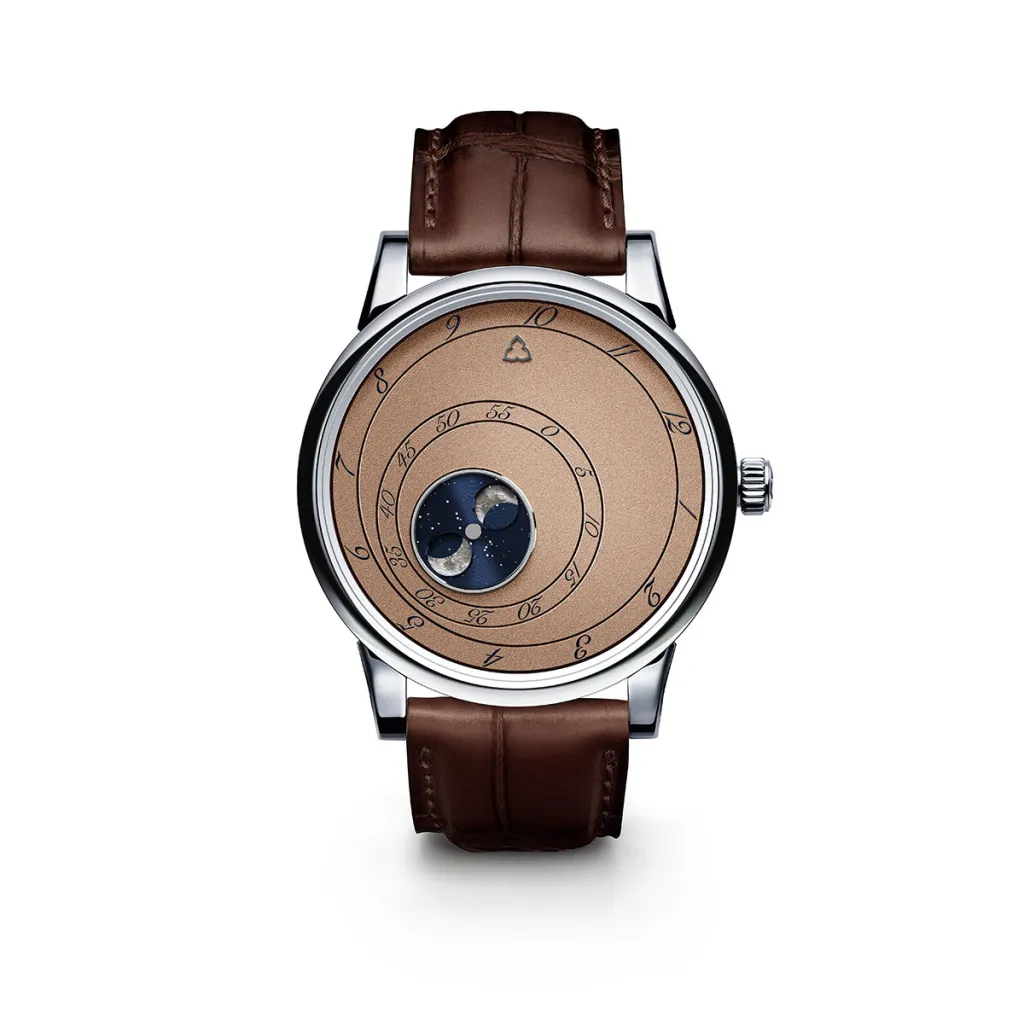
In 2018, Paris-based Trilobe introduced its Les Matinaux (“The Morning”) collection, and with it, a new way of telling the time. Employing a wandering display, the watch used three discs that rotated counterclockwise and three fixed pointers to indicate the hours, minutes and seconds. Named after a collection by the midcentury French poet René Char, the series recently spawned a new sand-colored Dune edition that marks the brand’s entrée into the world of complications. Limited to 100 pieces, the model, dubbed L’Heure Exquise (“The Exquisite Hour”), features a moonphase complication that evokes the orbit of the Moon around the Earth against the backdrop of a starry night sky. $21,995
Chanel Monsieur de Chanel Édition Superleggera Intense Black
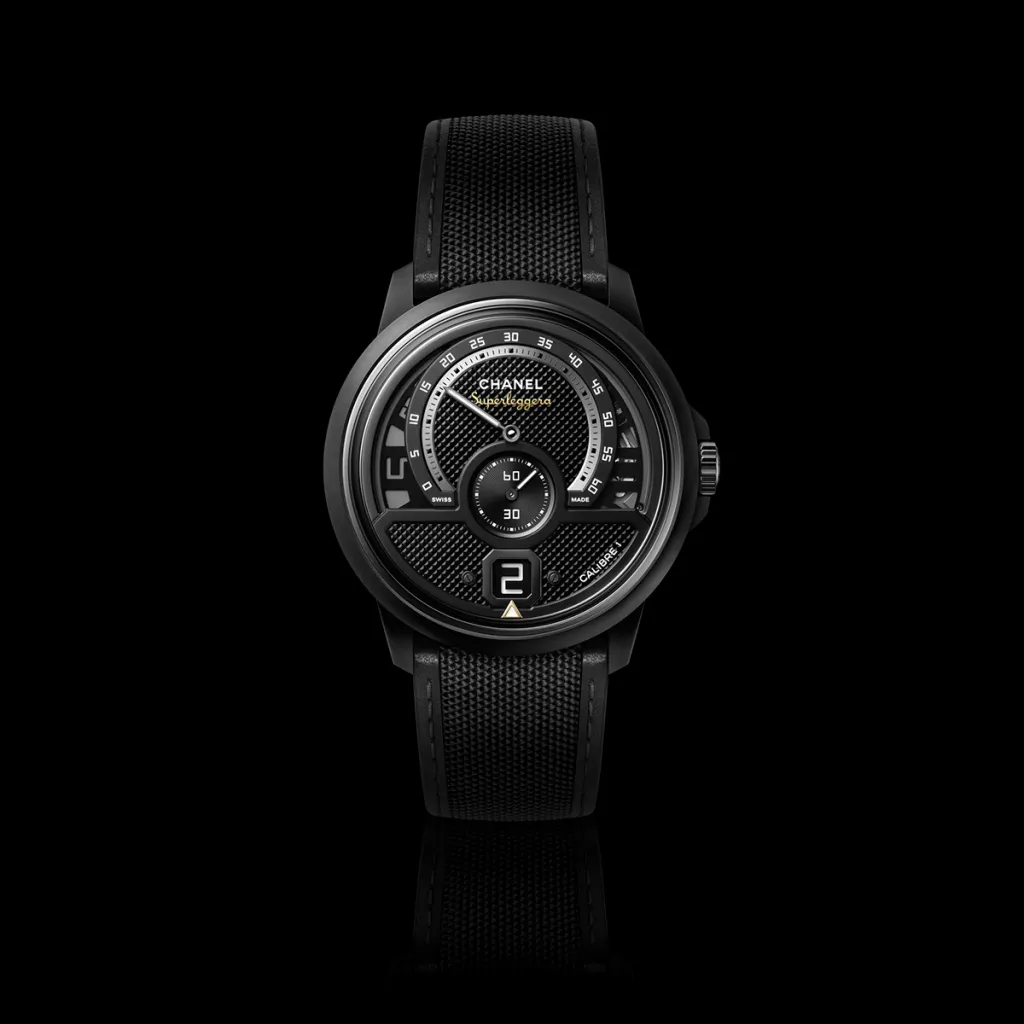
Arguably the Frenchiest brand on our list, Chanel made a name for itself as a high-end (as opposed to fashion) watchmaker in 1999, when it introduced its signature timepiece, the J12 (in unusual-for-the-time ceramic, no less). At Watches and Wonders Geneva in April, the brand upped the ante with its latest Monsieur timepiece, the Superleggera Intense Black, a limited edition of 100 pieces inspired by car racing. Housed in a matte black ceramic and steel case, the watch features a matte black guilloché dial and comes on a black nylon strap with black calfskin leather trim and lining. $69,651
Hermès Arceau Grand Tralala Brides et Mors
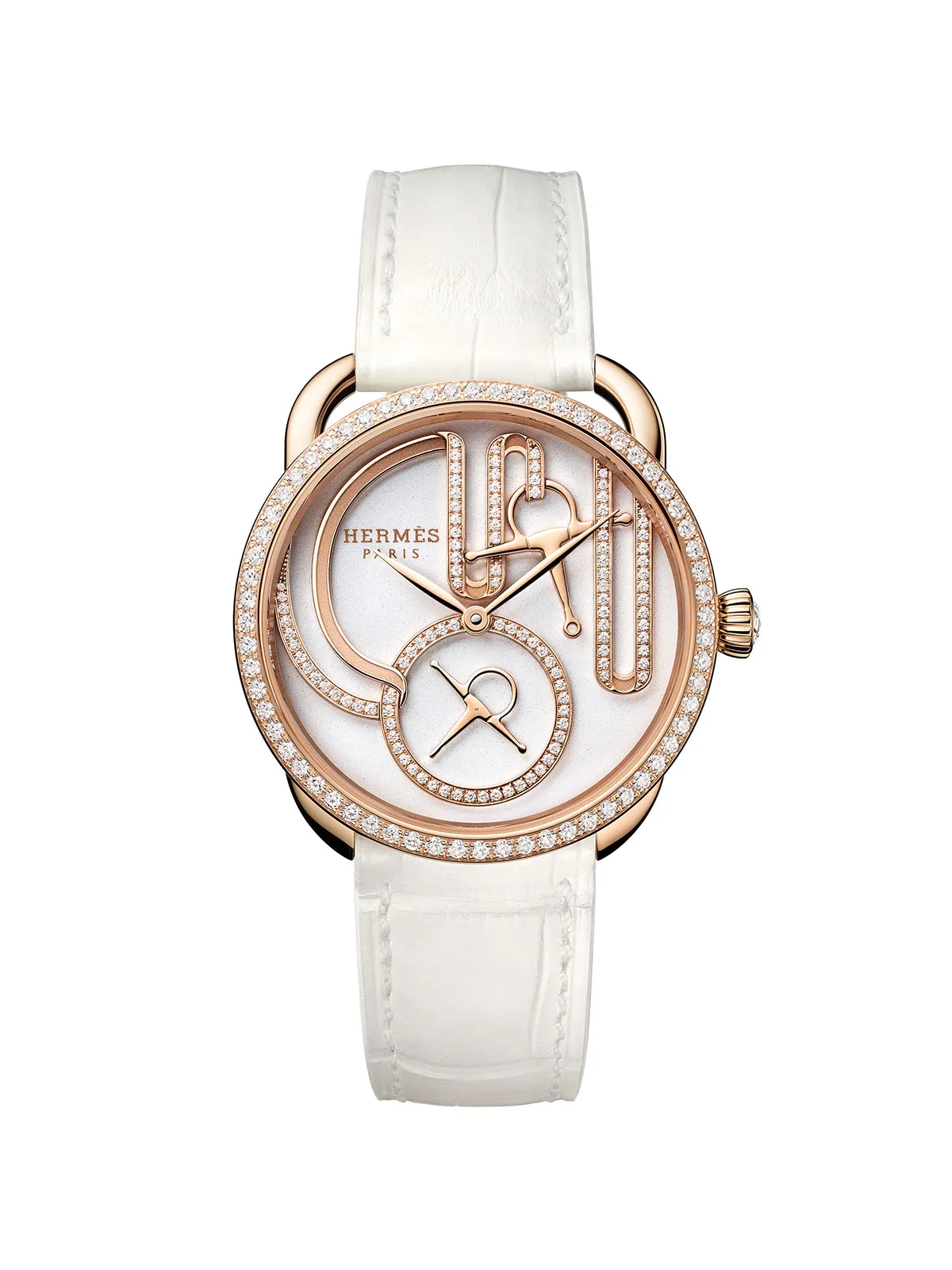
Like so many of Hermès’s most sought-after watches, the new 34 mm Arceau Grand Tralala Brides et Mors traces its design to another Hermès product, in this case the Grand Tralala silk scarf created by French artist Virginie Jamin. Patterned after the prestigious harnesses worn by the Royal Hungarian Bodyguard in the 19th century, the graphic design evokes the look of intertwined bridles and bits within a rose gold frame. Note the bit-shaped seconds hand! $72,172
Louis Erard x Alain Silberstein Smile-Day
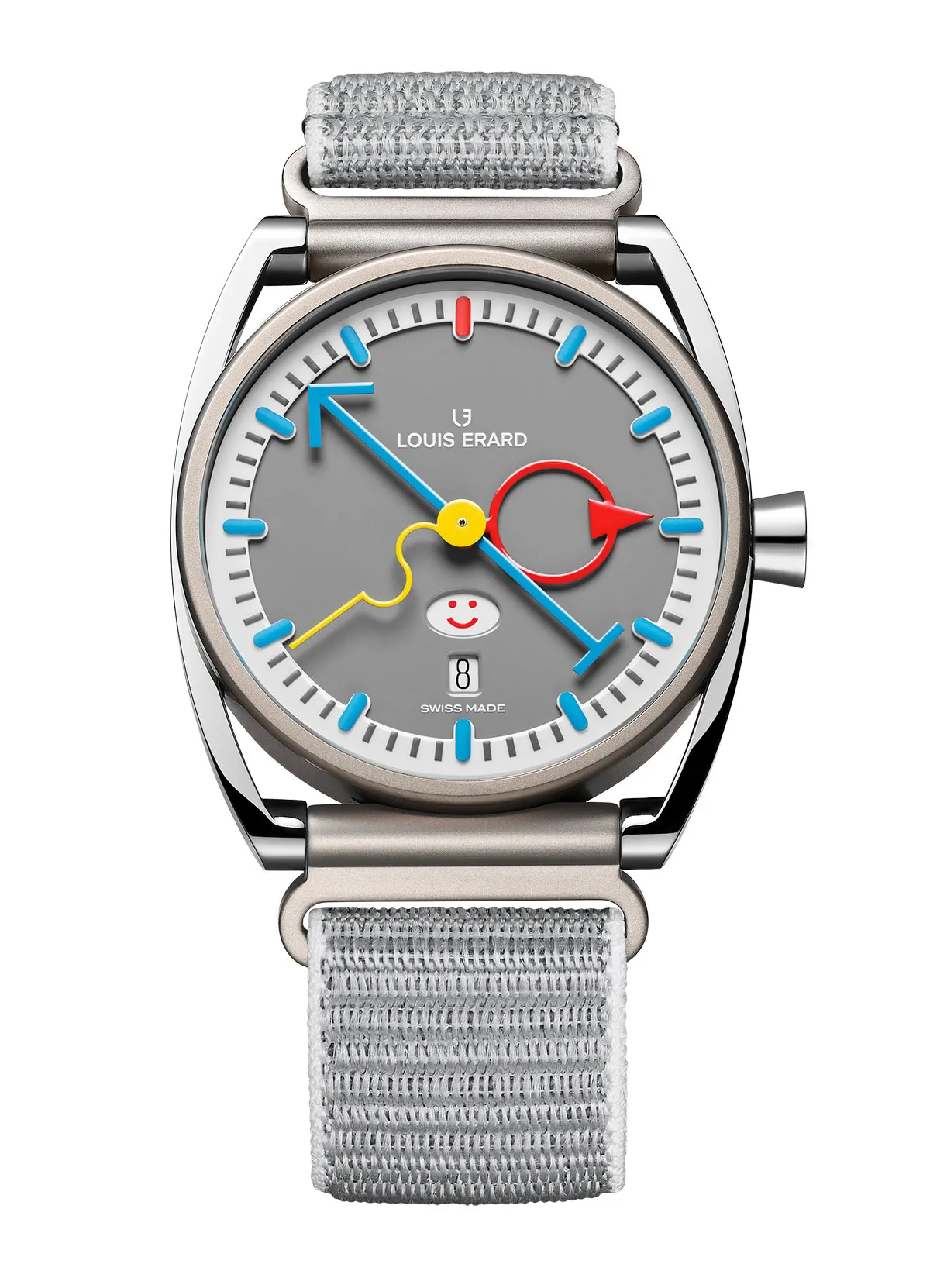
Imagine if Rolex’s much-talked-about emoji watch of 2023 had a child with the Memphis Group, a collective of Milan-based architects and designers who became known in the 1980s for their use of bright primary colors and bold patterns. That’s a quick way to describe the new 40 mm Smile-Day limited edition in titanium from Swiss watchmaker Louis Erard, whose latest collaboration with the iconoclastic French watchmaker Alain Silberstein reflects his signature whimsy. Silberstein was trained in graphic design and architecture in Paris by former members of Germany’s Bauhaus faculty, and he takes his whimsy very seriously. Between the aperture at six o’clock featuring a sliding carousel of seven emojis, the yellow squiggly seconds hand and the nostalgic color scheme, the piece is an instant classic. $8,019
Louis Vuitton Escale
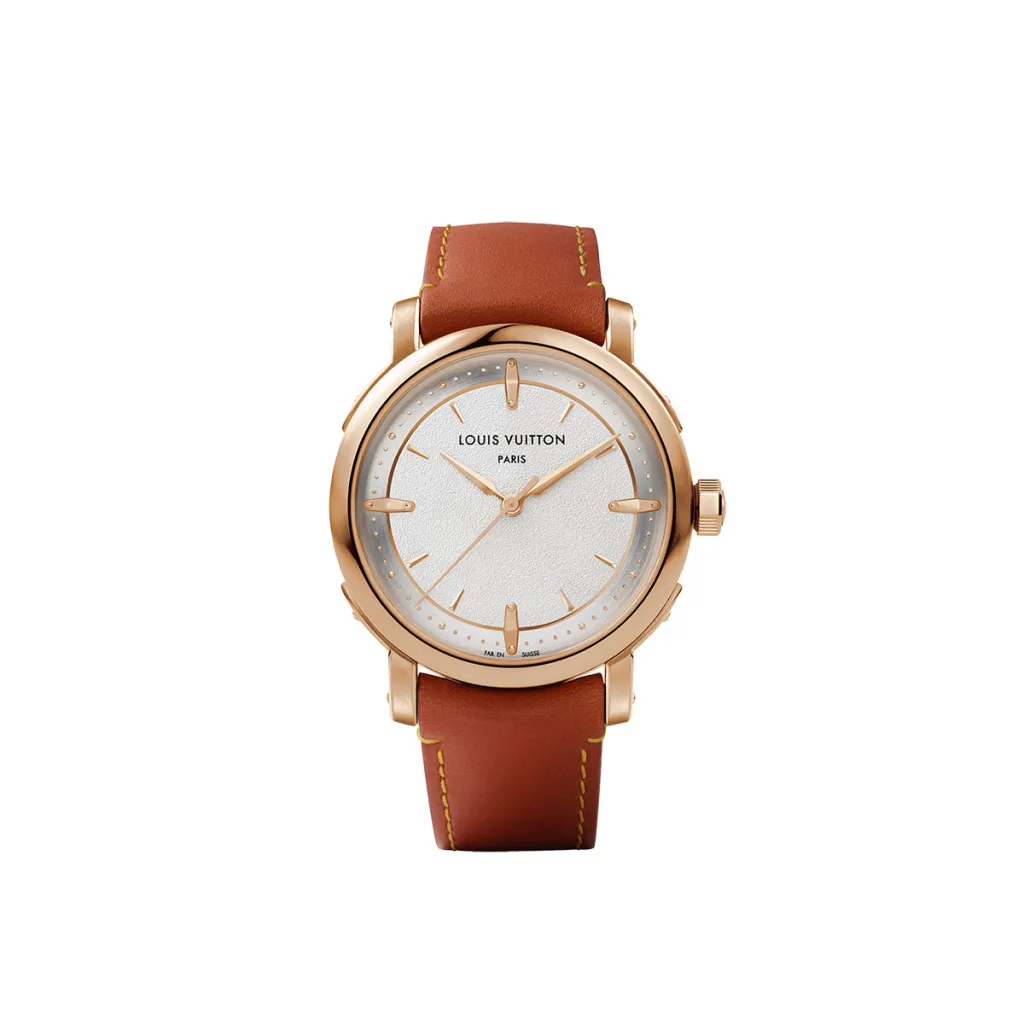
The dress watch revival continues with the new Escale by Louis Vuitton, an elegant timepiece honoring the 10th anniversary of the Escale collection (its first time-only, three-hand watch). Of the four new models in the line, two come in rose gold (like the 39 mm automatic model shown here), while the other two come in platinum. The former feature textured dials designed to evoke the suppleness and tactility of the Louis Vuitton Monogram canvas on metal. Equipped with a chronometer-certified movement with 50 hours of power reserve, the rose-gold Escale comes on a calf-leather strap. In a press release, the brand made sure to emphasize the model’s roots: “Just below the 12 o’clock hour marker, under the Louis Vuitton logo, is one word that encapsulates everything there is to be known about the Escale’s creative rebirth: Paris.” $40,324
Bell & Ross BR 03 Diver Full Lum
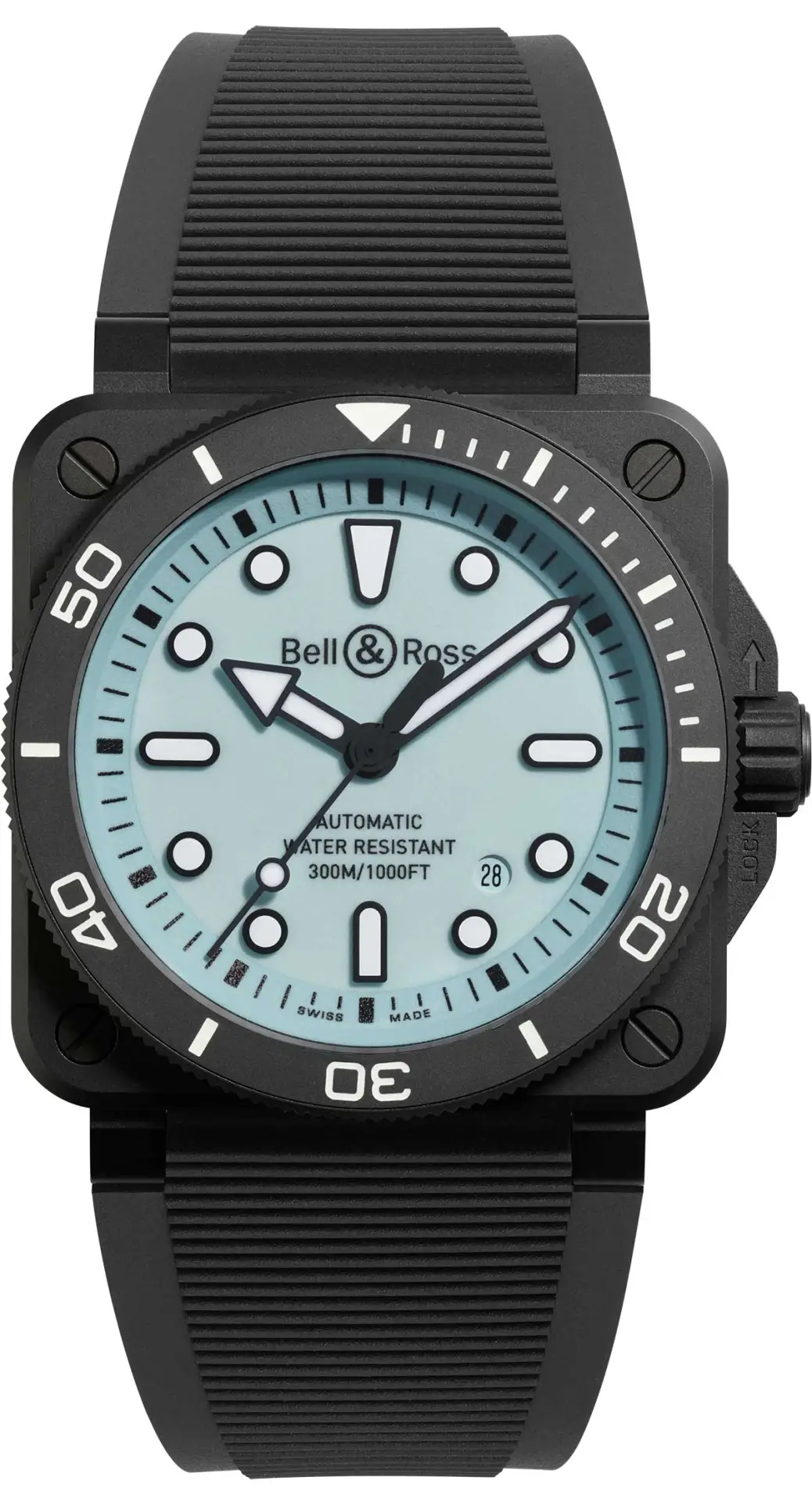
The BR03 Diver from Paris-based Bell & Ross celebrates its seventh anniversary this year. Recognised as the first square diving watch, the 2024 edition is new in more ways than one. Composed of five new models, including the full lume version with a pale blue dial shown here, the series is equipped with an improved automatic movement boasting 54 hours of power reserve, new typography, redesigned hands for optimal legibility and a new adaptable strap. $8,248
You may also like.
How Paris’s Dining, Hotel and Art Scene Got Their Groove Back — Just in Time for the Olympics
The French capital’s cultural life was already on the upswing. Mix in a major global sporting event, and it’s now ready to go toe to toe with any city in the world.
Host cities of modern-day Olympic Games have gotten into the competitive spirit by trying to stage the most spellbinding, over-the-top opening ceremony on record. Beijing enlisted 2008 drummers. London featured James Bond escorting Queen Elizabeth II. All Rio needed to wow the crowd was Gisele, who turned the stadium into her personal catwalk, strutting the length of the field solo. But only Paris could make the unprecedented gamble that the city itself is spectacular enough to be the star of the show.
If all goes according to plan when the Summer Olympics alight in Paris this July, the opening ceremony will play out like a Hollywood epic: timed to coincide with the sinking of the sun, an open-air flotilla of boats will ferry the athlete delegations on the Seine, sailing toward the sunset as hundreds of thousands of spectators cheer from either side of the river’s banks and the bridges above, all bathed in the amber afterglow.
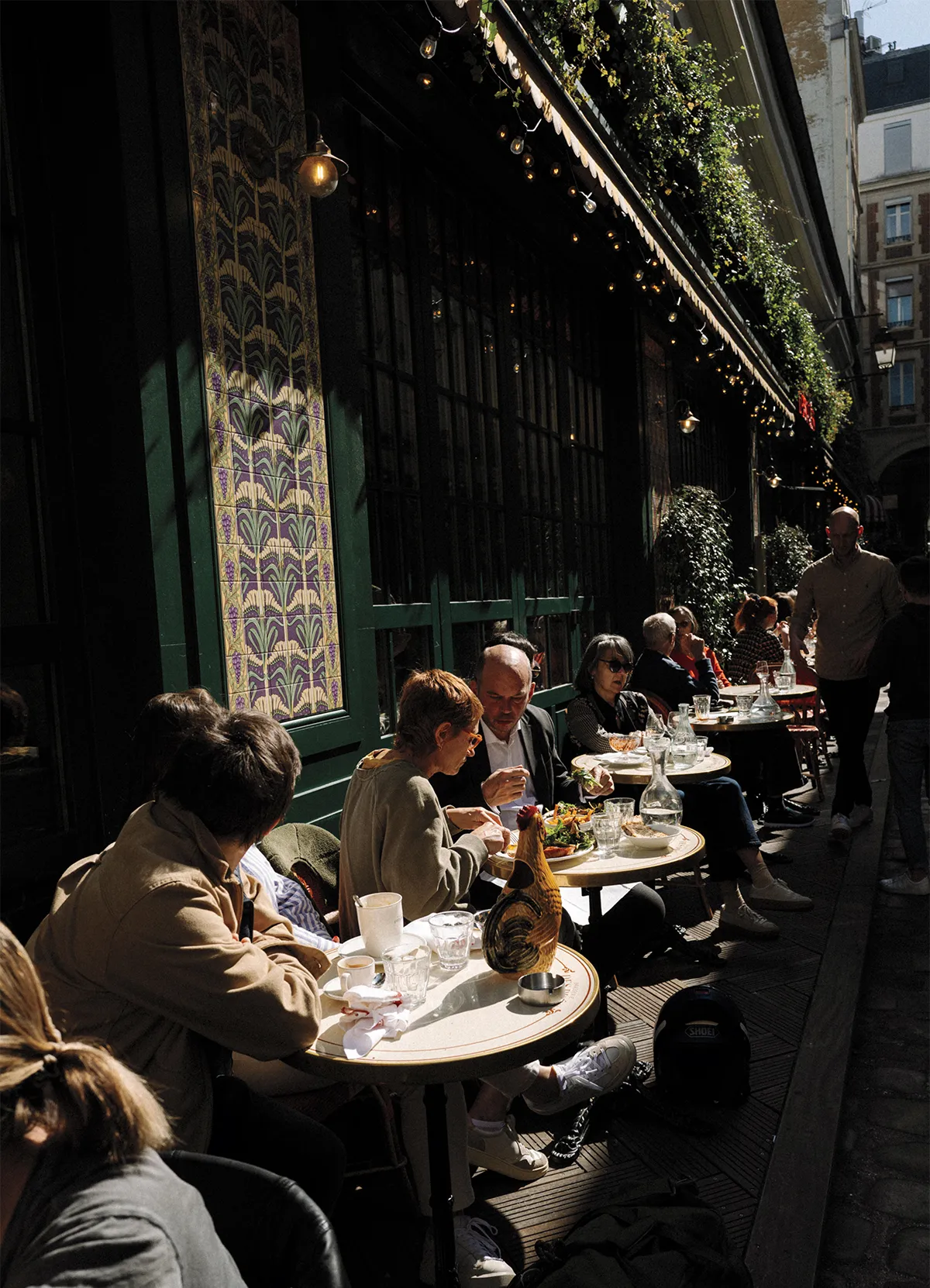
Nico Therin
It will mark the first time the ceremony will be held outside a stadium, let alone on a waterway. So too many of the events themselves, instead of being mounted in mostly generic stadiums on the outskirts of the city, will take place in the heart of Paris, reframing the French capital in a way that locals and visitors alike have never experienced—and that’s sure to dial up the promise of pageantry and emotion.
The Eiffel Tower’s latticed silhouette will serve as the backdrop for beach volleyball at Champs de Mars. Place de la Concorde, where more than a thousand people (including Louis XVI and Marie Antoinette) had their heads lopped off during the French Revolution, will be the site of newly admitted Olympic sports such as skateboarding and breakdancing. And though Olympic swimmers have raced in pools since 1908, this year’s athletes are slated to compete in the river itself. (Competitions will also take place in cities across France, from Lyon to Marseille, and Tahiti in French Polynesia will host the surfing event.)
The specs are ambitious and inventive, and in some ways could restore the city’s reputation for audacity. Because while the City of Light may be known as the cradle of fashion, culture and gastronomy, not too long ago it was also regularly accused of slipping into a lazy, even smug, complacency—stuck in its ways, resting on the laurels of its storied past.
In the food world, those doldrums translated into controversial snubs from the influential World’s 50 Best Restaurants list, known for flushing out avant-garde chefs. The French Michelin Guide, once considered the ultimate arbiter of fine dining, suddenly seemed staid and irrelevant. London and Berlin took Europe’s centre stage in art and design. Even President Emmanuel Macron described his fellow countrymen as resistant to change, much to the ire of those fellow countrymen—and countrywomen.

But influential creatives and Parisians say that in the years leading up to the Games, and particularly since the pandemic, something has shifted. “I really think that during the last 10 years, Paris opened itself to more new things, for different trends,” says Hélène Darroze, the acclaimed chef whose six restaurants include Michelin two-star Marsan in Paris and her three-star namesake at The Connaught in London. “Paris is happier than before, more joyful than before.”
There’s a giddy sense of anticipation, says the illustrator Marin Montagut, who has collaborated with Le Bon Marché and the Ritz Paris and owns an eponymous boutique in Saint-Germain-des-Prés where he sells hand-painted glassware and porcelain decor. “It feels like Paris is trying to look very, very pretty for a very important evening. She’s been getting some plastic surgery and is trying to get ready in time,” he says with a chuckle. “There’s just a lot of effervescence in the city.”
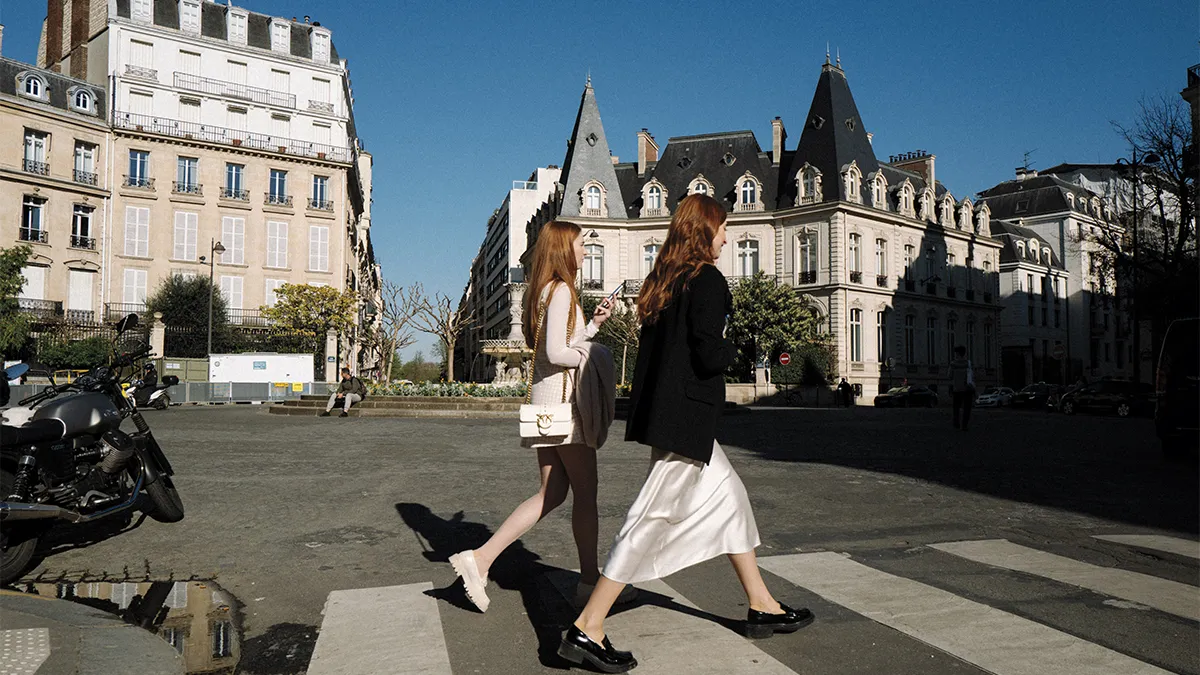
Nico Therin
For better or for worse, some of the credit for that renewed vitality belongs to the light-as-soufflé Netflix series Emily in Paris, which quickly became the collective escapist fantasy for viewers around the world who were grounded by the Covid-19 virus. Another part of that newfound energy, though, can be traced to the frenzied building of luxury hotels, restaurants, galleries, museums and boutiques over the past few years, including Montagut’s own Paris-themed shop, which he opened in 2020.
In the past three years alone, 25 new five-star hotels debuted across the city, bringing the total to 101. Noteworthy newcomers include Madame Rêve, Kimpton St. Honoré Paris, Château des Fleurs, Maison Proust, LVMH’s Cheval Blanc Paris, and Chopard’s first boutique hotel here, 1 Place Vendôme. The dual autumn 2023 openings of Le Grand Mazarin and La Fantaisie hotels marked the Paris debut of Swedish designer Martin Brudnizki, whose playfully modern, maximalist and flamboyant aesthetic injected colour and character into Paris’s elite hotel scene.
In parallel with the growth of traditional hotels, new players in the luxury rental market are emerging, joining the likes of Le Collectionist and Belles Demeures. Founded in 2020, Highstay rents out luxury serviced apartments equipped with kitchens and living spaces. The firm’s current portfolio includes 36 apartments in areas such as the Champs-Élysées and Saint-Honoré, and another 48 are under construction—all of which it owns. There is no check-in (guests are sent digital access codes) and all concierge requests, including housekeeping and travel reservations, are made via live chat on a dedicated guest portal. “The goal is that guests get the real Parisian experience and feel like an insider, like a city dweller,” says general director Maxime Lallement.
The idea of making Paris as welcoming as a second home is also what drives the luxury real-estate market for foreign buyers, particularly Americans, says Alexander Kraft, CEO of Sotheby’s International Realty France-Monaco. He sees 2024 as a “transition year” and says that the local market is moving at two different speeds: while demand for properties between roughly $1.5 million and $8.5 million has cooled, high-end properties between about $17 million and $85 million continue to sell fast among buyers from the Middle East. Kraft predicts the market will pick up in 2025 following the US presidential election. “Paris is one of those real-estate markets that is eternally popular,” he says. “Contrary to other international cities, it really has broad appeal.”
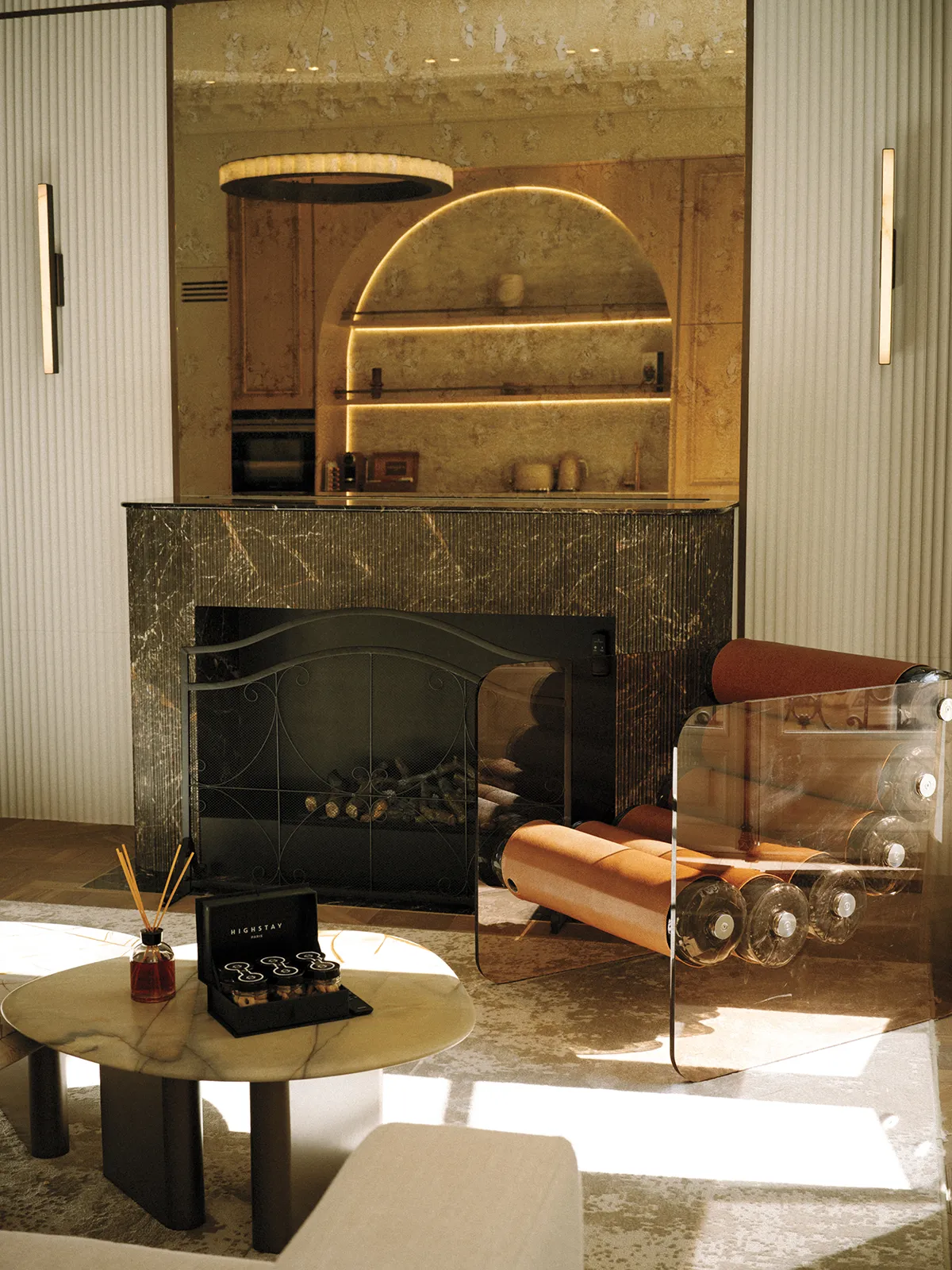
Nico Therin
Montreal-born, New York–based interior designer Garrow Kedigian is one of those frequent visitors who decided to take the leap and buy his own pied-à-terre in Paris a few years ago, after a lifetime of travelling back and forth for both work and pleasure.
As a part-time resident, Kedigian says he too has noticed a palpable shift in the city’s vibe, which he attributes to a renewed appreciation for tourists following their absence during the pandemic, as well as an “international flair” that has given the city a fresh spark. “There’s a lot more cultural diversity than there was before,” he says. “In that respect it’s a bit like New York. And I think that now the interface between Paris’s unique flavour and the international populace is a little bit smoother.”
For Montagut, one of the best examples of this synergy can be found in Belleville, in the city’s east end, where independent artists, musicians and other urban creatives rub shoulders in Chinese, African, and Arab restaurants and businesses. “There’s a social and cultural diversity here, and for me this is really important,” Montagut says. “If Paris was just the 6th arrondissement, it would be boring.”
The eastern edge of Paris is also one of the preferred neighbourhoods of Michael Schwartz, the marketing and communications manager for Europe at French jewellery house Boucheron. A recent New York City transplant, he is drawn to the burgeoning number of gastronomic gems far from the madding tourist crowds.
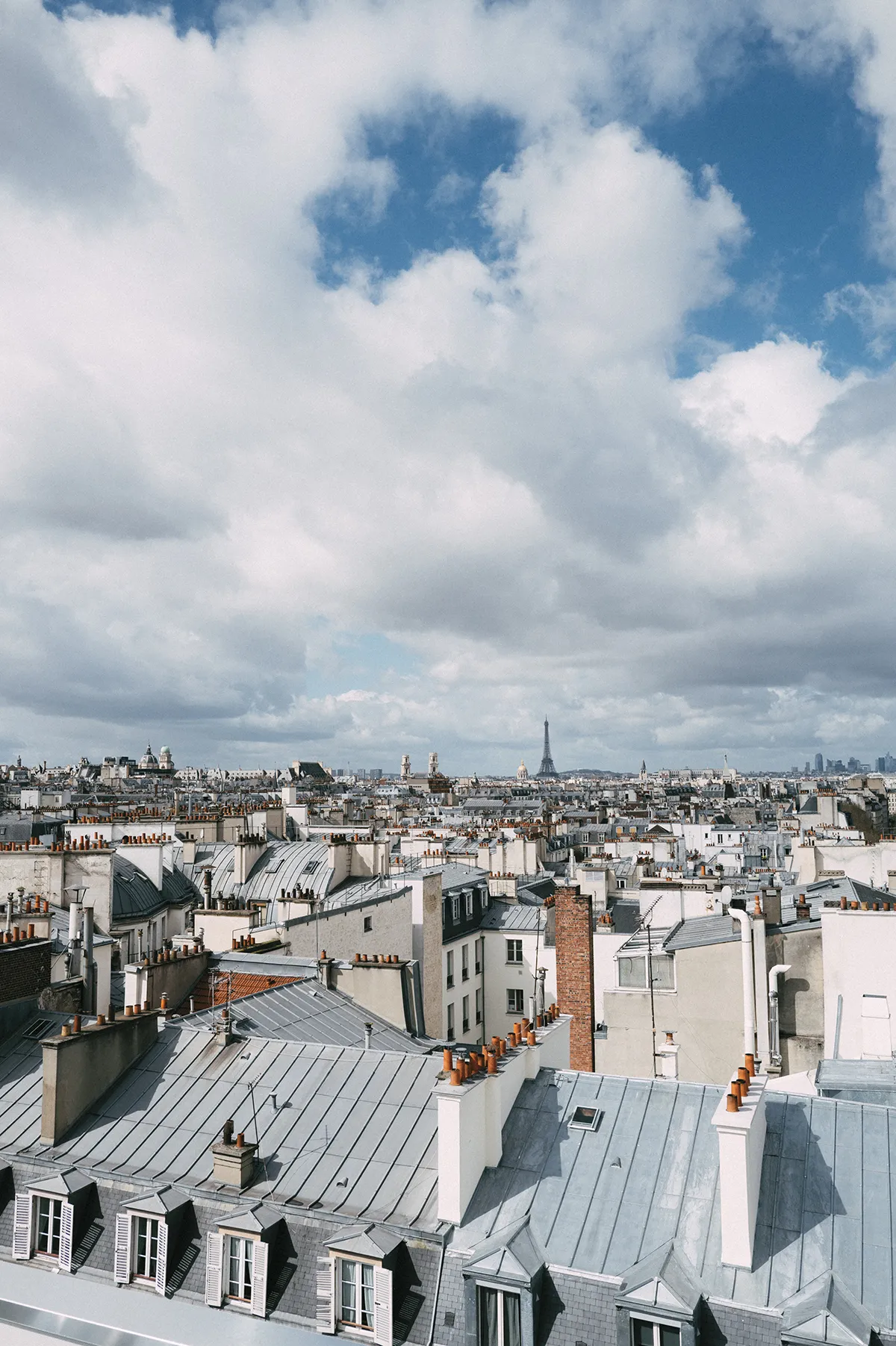
Nico Therin
He points to sister restaurants Caché and Amagat (the names mean “hidden” in French and Catalan, respectively), discreetly located at the end of a cobblestoned cul-de-sac, as favourites. With backgrounds in fashion and advertising, the Italian duo who run them have attracted equally fashionable locals to this hitherto quiet part of town. Caché serves up fresh Mediterranean seafood dishes, while next door, Amagat specialises in Catalan tapas.
Then there’s Soces, a corner seafood bistro on rue de la Villette, where you might find Jean-Benoît Dunckel, who co-wrote the score to Sofia Coppola’s film The Virgin Suicides when he was part of the electronic-music duo Air (Dunckel’s recording studio is in the area), or the French designers behind the Coperni fashion line, Sébastien Meyer and Arnaud Vaillant. “This is a really special restaurant,” says Schwartz. “It’s frequented by really cool creatives, designers and musicians, and it’s kind of a destination restaurant for most people because it’s not central.”
What makes Paris’s dining scene so exciting now, according to Stéphane Bréhier, editor in chief of French restaurant guide Gault& Millau, is a sense of fearlessness among younger chefs who reject the traditional trajectory that begins with a lowly stage in a Michelin-star kitchen. What’s more, visitors are likewise foregoing Michelin establishments in favour of newer, more experimental dining spots. “Over the last few years, there’s been a profusion of young chefs who don’t want to work for other people and are daring to set up their own shop,” Bréhier says. “The gastronomic scene is booming in Paris.”

Nico Therin
These bold, emerging chefs feel less bound not only to their elders but also to French cuisine itself. “It has changed a lot,” says Hélène Darroze, who opened Marsan, her first Parisian restaurant, 25 years ago. “The new generation travelled a lot—in South America, for example, in Asia—before opening a restaurant or being a head chef somewhere. They opened themselves to other cultures. This is why the culinary scene at the moment is very interesting in Paris; because it’s a mix of very famous chefs with Michelin stars but also young chefs who don’t care about Michelin stars—they just want to explore so many fields.”
The ever-growing importance of social media and its insatiable hunger for envy-inducing images is driving another major trend in the dining scene: rooftop spots, including Mun and Girafe in the Golden Triangle, the area bordered by avenues Montaigne and George V and the Champs-Élysées. “A lot of rooftops have opened in Paris, where before they were pretty much nonexistent apart from the Eiffel Tower and the Montparnasse Tower,” says Dimitri Ruiz, head concierge at Hôtel Barrière Fouquet’s Paris on the Champs-Élysées.
Five-star Right Bank hotels SO/ and Cheval Blanc Paris have watering holes that offer sweeping vistas of the Seine. But perhaps the most coveted perch during the opening ceremony will be the Champagne bar at La Tour d’Argent restaurant, which boasts unobstructed views of the Notre-Dame Cathedral and the Seine. (And yes, someone already had the idea to book it for a private event.) Famous for its signature pressed duck as well as for hosting monarchs and heads of state, the historic restaurant recently underwent a major renovation that included the addition of the aerie, which opened late last summer. “It’s only been in the last 10 years or so that Paris has been developing rooftops, and it’s really taking off like wildfire,” says third-generation owner André Terrail.
Paris’s venerated fashion industry has also found ways to innovate, with fresh faces keeping their fellow couturiers on their toes and the shopping options enticing. In 2022, for example, Simon Porte Jacquemus opened his first boutique in the city on avenue Montaigne—home to Gucci, Chanel, and Prada, among other venerable names—and in March, at the age of 34, became France’s youngest fashion designer to be named a Chevalier de l’Ordre des Arts et des Lettres for his contributions to the field. That kind of success has a ripple effect in the creative community.
“Almost every street has the name of an artist or a politician,” says Charaf Tajer, the Parisian-born creative director behind the London-based Casablanca sportswear line. “So the city reminds me always that the people who came before me, who walked those streets, created the future in a way. As much as [Paris] seems stuck in time visually, you can also feel the energy of people creating the present.”
Interior designer David Jimenez, whose 2022 book Parisian by Design compiles his Francophile projects, moved to the city in 2015 and spent his first few years living near the Champs-Élysées, which he says has undergone a noticeable revival. Along with Jacquemus’s arrival, new luxury openings or expansions—including Burberry, Saint Laurent, Bottega Veneta, and Panerai—and city-led greening efforts are bringing Parisians back to the 8th arrondissement, long dismissed as an overcrowded tourist trap where fast-food and fast-fashion chains had colonised the once glamorously luxe avenue. Now, Dior’s captivating Peter Marino–designed museum draws legions of fans, while the city has been busy planting more trees, renovating gardens and repairing damaged sidewalks as part of a long-term embellishment plan. And on the first Sunday of every month, the entire length of the Champs-Élysées becomes a pedestrian-only promenade. “It’s an exciting evolution in a part of the city that seemed sleepy and perhaps lost its way a little bit,” Jimenez says. “Now there’s a thrust forward.”
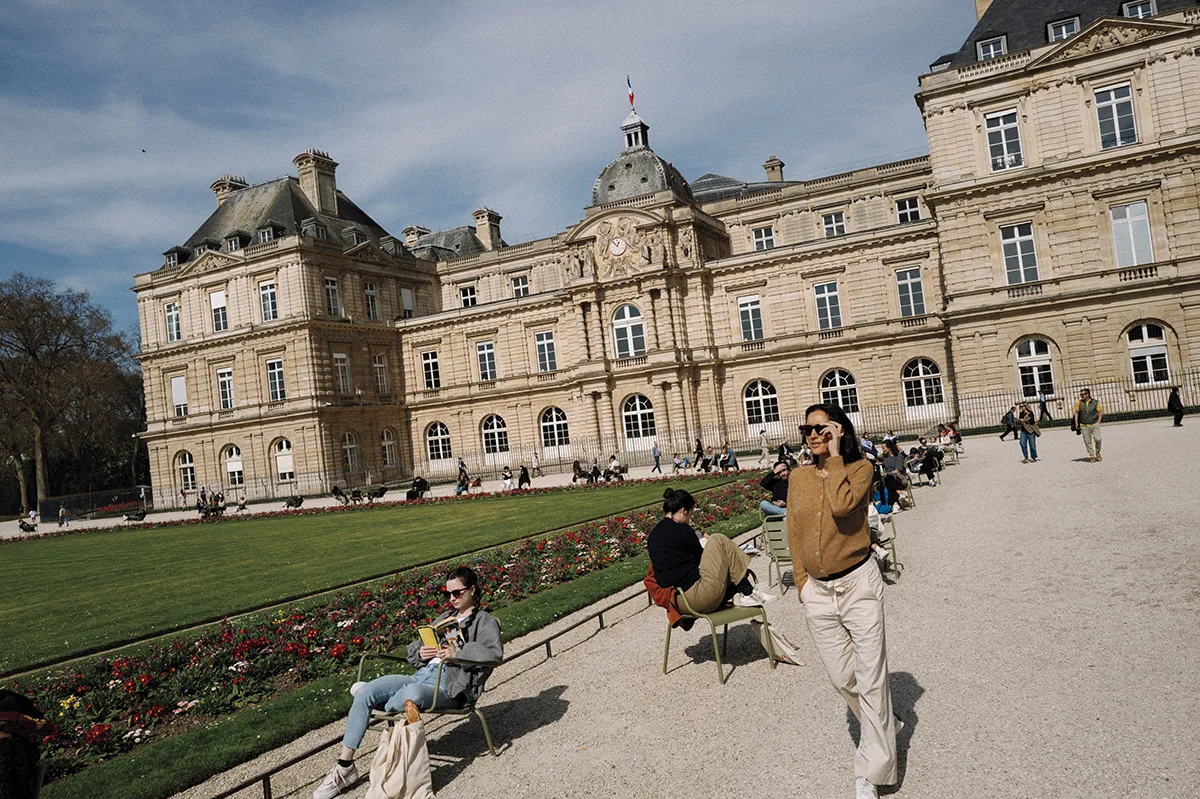
Nico Therin
The thriving fashion houses are responsible for more than maintaining the city’s unparalleled reputation for chic. To a large degree, they have also helped revive its status as an art capital. The billions generated by LVMH (parent of Louis Vuitton, Dior and Berluti, among others) and Kering (Alexander McQueen, Gucci, Bottega Veneta, et al.) funded the extraordinary contemporary art collections amassed by their founders, Bernard Arnault and François Pinault, respectively. The rivals rewarded their hometown with two museums, Fondation Louis Vuitton and Bourse de Commerce, that have helped make it a leader in contemporary art.
Also lending a hand: Brexit, which persuaded many international galleries to brush up on their French. One of the most talked-about recent additions is the powerhouse Hauser & Wirth, which opened in a 19th-century hôtel particulier near the Champs-Élysées last year. David Zwirner arrived in 2019, Mariane Ibrahim in 2021, and Peter Kilchmann the following year, all joining long-established Parisian galleries including Perrotin and Thaddaeus Ropac. The City of Light even snagged its own coveted annual installment of Art Basel: Paris+, which now runs every October in the Grand Palais.
“Quite frankly, Paris has been putting up some of the most incredible exhibitions in institutions in Europe,” says Serena Cattaneo Adorno, senior director at Gagosian. “And a lot of private collectors have also decided to open spaces in the city, creating a great dynamic between public and private galleries.”
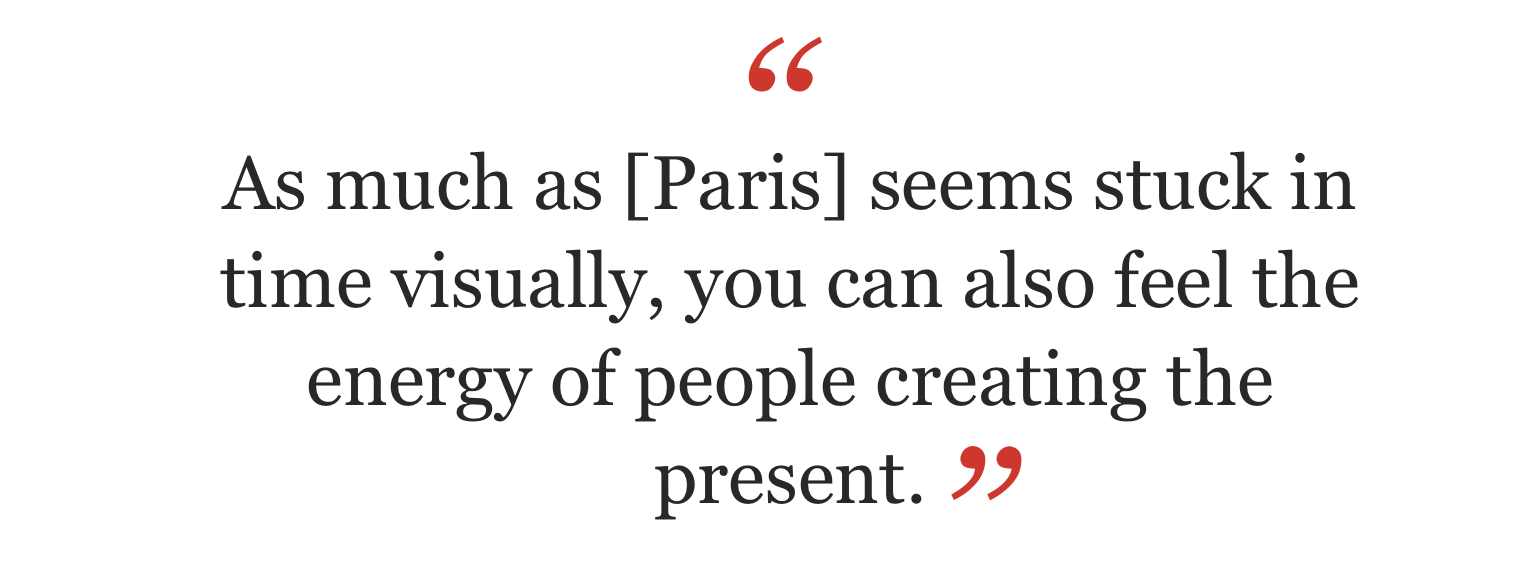
The always-savvy Gagosian, on rue Ponthieu, has hit upon an authentic tie-in with the Games: a summer exhibition featuring Olympic posters created over the years by celebrated artists from Picasso on up to Warhol, Hockney and Tracey Emin. “Once you start digging, you find that a lot of artists have reflected on sports and the engagement of the body,” Cattaneo Adorno says. “It’s just a really pure and beautiful message about how art and sports have dialogues that can be somewhat surprising.”
A few months out from the festivities on the Seine, interior decorator Jimenez sums up the mood of many locals, saying (only half-jokingly), “I think for most Parisians, there’s a sense of curiosity, optimism, excitement—and an exit plan, in that order.”
While polling shows that nearly half of Parisians intend to vacate the city during the games, Jimenez notes that he will be watching the opening ceremony with friends who live in an apartment overlooking the Seine. “I want to be part of the excitement. I want to see as much as I can and be energised by this very special and unique moment,” he says. “It’s a once-in-a-lifetime opportunity, and I am deeply grateful to be able to experience it first-hand as an American living in Paris.”
Additional reporting by Lucy Alexander and Justin Fenner.
You may also like.
Watches & Wonders 2024 Showcase: Hermès
We head to Geneva for the Watches & Wonders exhibition; a week-long horological blockbuster featuring the hottest new drops, and no shortage of hype.
With Watches & Wonders 2024 well and truly behind us, we review some of the novelties Hermès presented at this year’s event.
—
HERMÈS
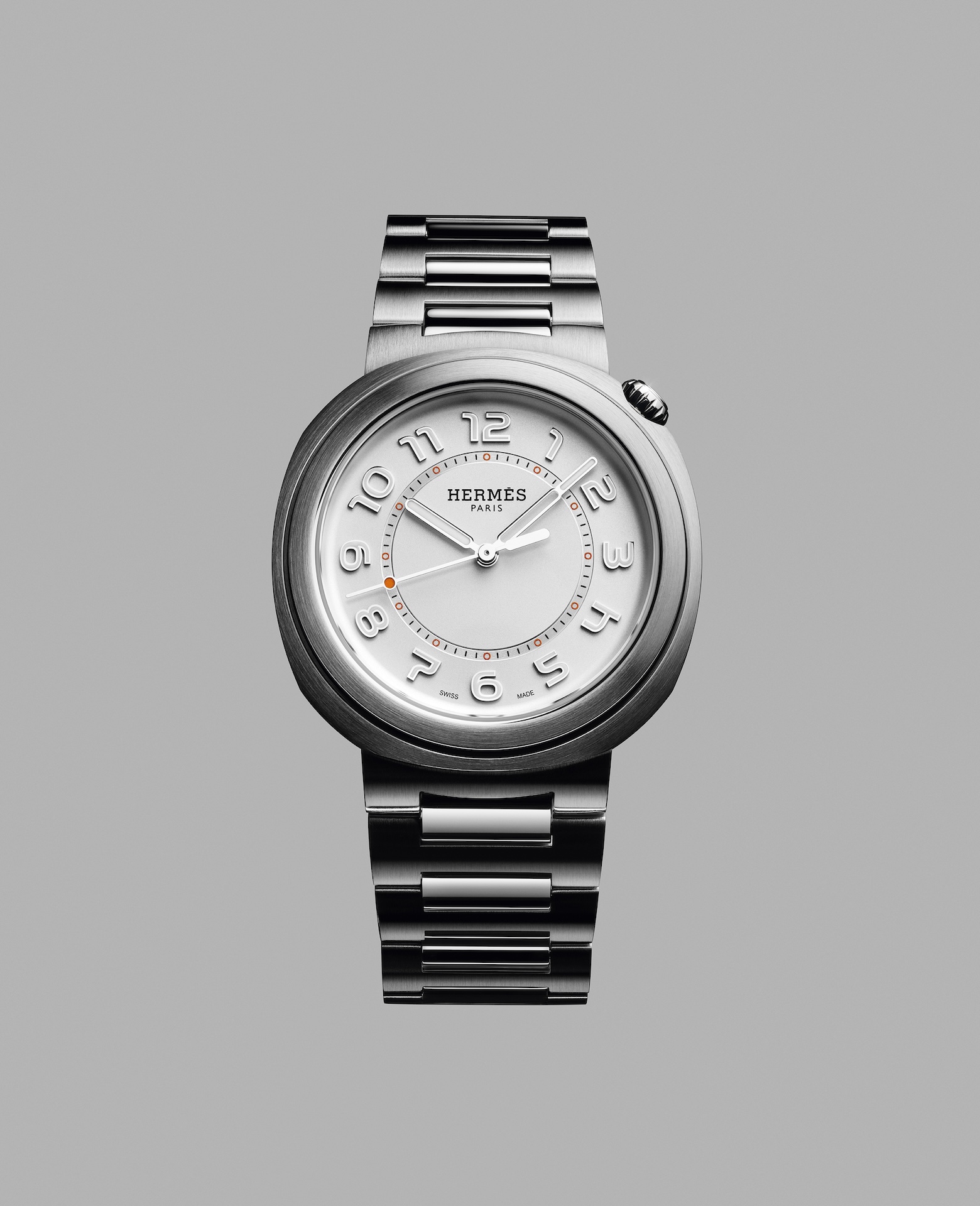
Moving away from the block colours and sporty aesthetic that has defined Hermès watches in recent years, the biggest news from the French luxury goods company at Watches & Wonders came with the unveiling of its newest collection, the Hermès Cut.
It flaunts a round bezel, but the case middle is nearer to a tonneau shape—a relatively simple design that, despite attracting flak from some watch aficionados, works. While marketed as a “women’s watch”, the Cut has universal appeal thanks to its elegant package and proportions. It moves away from the Maison’s penchant for a style-first product; it’s a watch that tells the time, not a fashion accessory with the ability to tell the time.
Hermès gets the proportions just right thanks to a satin-brushed and polished 36 mm case, PVD-treated Arabic numerals, and clean-cut edges that further accentuate its character. One of the key design elements is the positioning of the crown, boldly sitting at half-past one and embellished with a lacquered or engraved “H”, clearly stamping its originality. The watch is powered by a Hermès Manufacture movement H1912, revealed through its sapphire crystal caseback. In addition to its seamlessly integrated and easy-wearing metal bracelet, the Cut also comes with the option for a range of coloured rubber straps. Together with its clever interchangeable system, it’s a cinch to swap out its look.
It will be interesting to see how the Hermès Cut fares in coming months, particularly as it tries to establish its own identity separate from the more aggressive, but widely popular, Ho8 collection. Either way, the company is now a serious part of the dialogue around the concept of time.
—
Read more about this year’s Watches & Wonders exhibition at robbreport.com.au
You may also like.
Watch This Space: Mike Nouveau
Meet the game-changing horological influencers blazing a trail across social media—and doing things their own way.
In the thriving world of luxury watches, few people own a space that offers unfiltered digital amplification. And that’s precisely what makes the likes of Brynn Wallner, Teddy Baldassarre, Mike Nouveau and Justin Hast so compelling.
These thought-provoking digital crusaders are now paving the way for the story of watches to be told, and shown, in a new light. Speaking to thousands of followers on the daily—mainly via TikTok, Instagram and YouTube—these progressive commentators represent the new guard of watch pundits. And they’re swaying the opinions, and dollars, of the up-and-coming generations who now represent the target consumer of this booming sector.
—
MIKE NOUVEAU

Can we please see what’s on the wrist? That’s the question that catapulted Mike Nouveau into watch stardom, thanks to his penchant for highlighting incredibly rare timepieces across his TikTok account of more than 400,000 followers. When viewing Nouveau’s attention-grabbing video clips—usually shot in a New York City neighbourhood—it’s not uncommon to find him wrist-rolling some of the world’s rarest timepieces, like the million-dollar Cartier Cheich (a clip he posted in May).
But how did someone without any previous watch experience come to amass such a cult following, and in the process gain access to some of the world’s most coveted timepieces? Nouveau admits had been a collector for many years, but moved didn’t move into horology full-time until 2020, when he swapped his DJing career for one as a vintage watch specialist.
“I probably researched for a year before I even bought my first watch,” says Nouveau, alluding to his Rolex GMT Master “Pepsi” ref. 1675 from 1967, a lionised timepiece in the vintage cosmos. “I would see deals arise that I knew were very good, but they weren’t necessarily watches that I wanted to buy myself. I eventually started buying and selling, flipping just for fun because I knew how to spot a good deal.”
Nouveau claims that before launching his TikTok account in the wake of Covid-19, no one in the watch community knew he existed. “There really wasn’t much watch content, if any, on TikTok before I started posting, especially talking about vintage watches. There’s still not that many voices for vintage watches, period,” says Nouveau. “It just so happens that my audience probably skews younger, and I’d say there are just as many young people interested in vintage watches as there are in modern watches.”
View this post on Instagram
Nouveau recently posted a video to his TikTok account revealing that the average price of a watch purchased by Gen Z is now almost US$11,000 (around $16,500), with 41 percent of them coming into possession of a luxury watch in the past 12 months.
“Do as much independent research as you can [when buying],” he advises. “The more you do, the more informed you are and the less likely you are to make a mistake. And don’t bring modern watch expectations to the vintage world because it’s very different. People say, ‘buy the dealer’, but I don’t do that. I trust myself and myself only.”
—
Read more about the influencers shaking up horology here with Justin Hast, Brynn Wallner and Teddy Baldassare.
You may also like.
5 Lounge Chairs That Add Chic Seating to Your Space
Daybeds, the most relaxed of seating solutions, offer a surprising amount of utility.
Chaise longue, daybed, recamier, duchesse brisée—elongated furniture designed for relaxing has a roster of fancy names. While the French royal court of Louis XIV brought such pieces to prominence in fashionable European homes, the general idea has been around far longer: The Egyptian pharaohs were big fans, while daybeds from China’s Ming dynasty spurred all those Hollywood Regency fretwork pieces that still populate Palm Beach living rooms. Even Mies van der Rohe, one of design’s modernist icons, got into the lounge game with his Barcelona couch, a study of line and form that holds up today.
But don’t get caught up in who invented them, or what to call them. Instead, consider their versatility: Backless models are ideal in front of large expanses of glass (imagine lazing on one with an ocean view) or at the foot of a bed, while more structured pieces can transform any corner into a cozy reading nook. Daybeds may be inextricably linked to relaxation, but from a design perspective, they put in serious work.
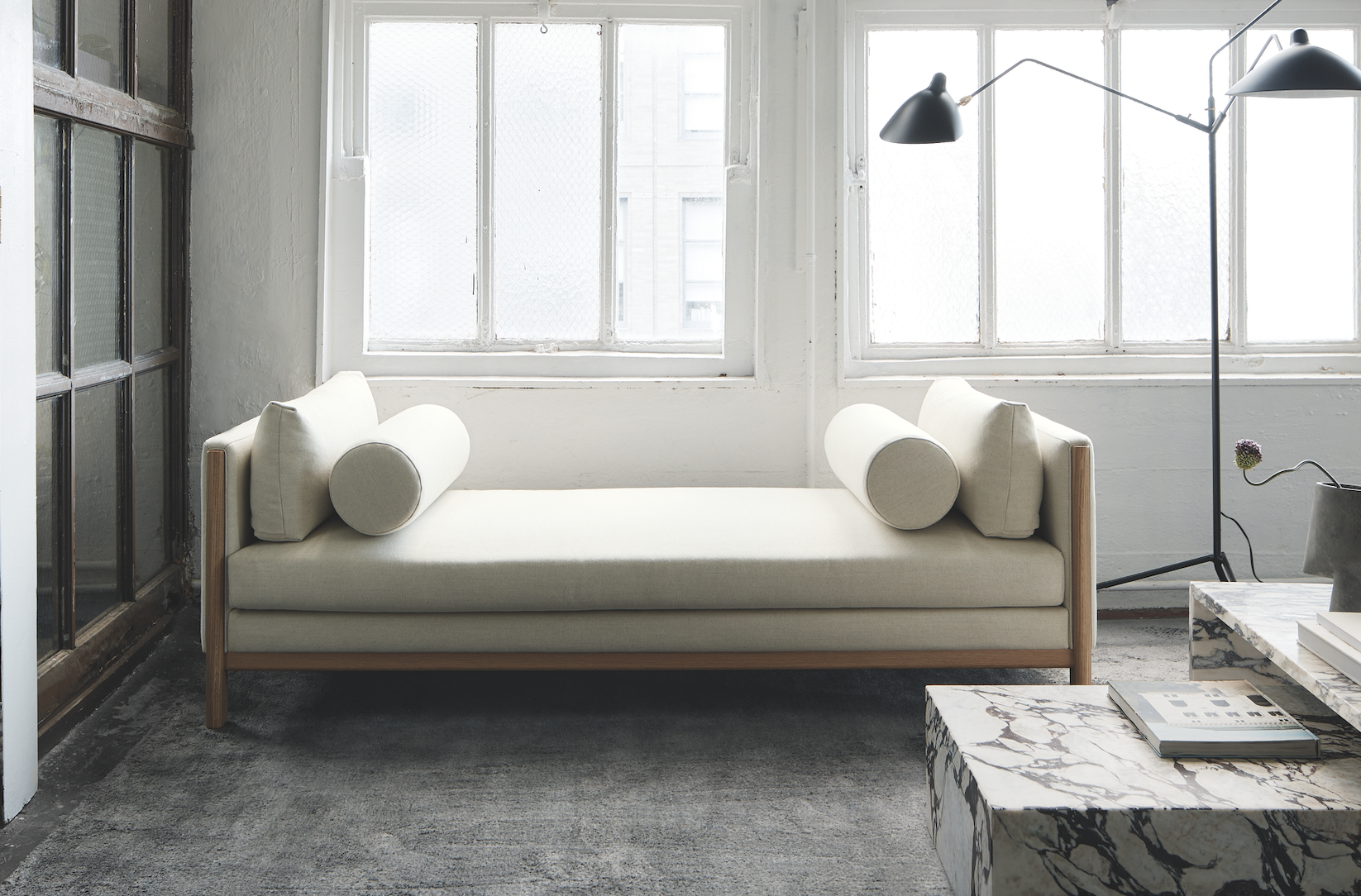
Emmy, Egg Collective
In designing the Emmy chaise, the Egg Collective trio of Stephanie Beamer, Crystal Ellis and Hillary Petrie, who met as students at Washington University in St. Louis, aimed for versatility. Indeed, the tailored chaise looks equally at home in a glass skyscraper as it does in a turn-of-the-century town house. Combining the elegance of a smooth, solid oak or walnut frame with the comfort of bolsters and cushioned upholstery or leather, it works just as well against a wall or at the heart of a room. From around $7,015; Eggcollective.com
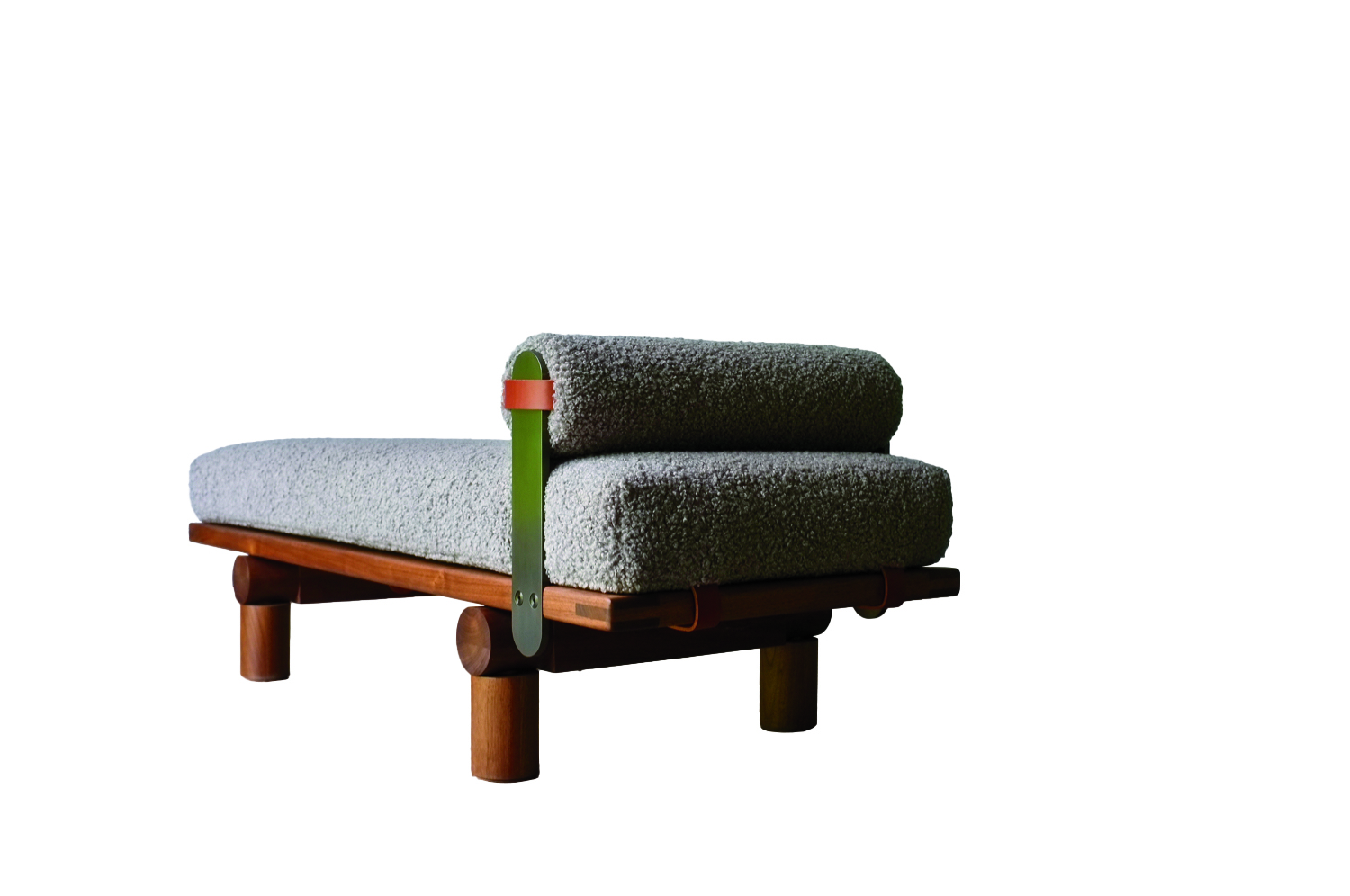 Plum, Michael Robbins
Plum, Michael Robbins
Woodworker Michael Robbins is the quintessential artisan from New York State’s Hudson Valley in that both his materials and methods pay homage to the area. In fact, he describes his style as “honest, playful, elegant and reflective of the aesthetic of the Hudson Valley surroundings”. Robbins crafts his furniture by hand but allows the wood he uses to help guide the look of a piece. (The studio offers eight standard finishes.) The Plum daybed, brought to life at Robbins’s workshop, exhibits his signature modern rusticity injected with a hint of whimsy thanks to the simplicity of its geometric forms. Around $4,275; MichaelRobbins.com
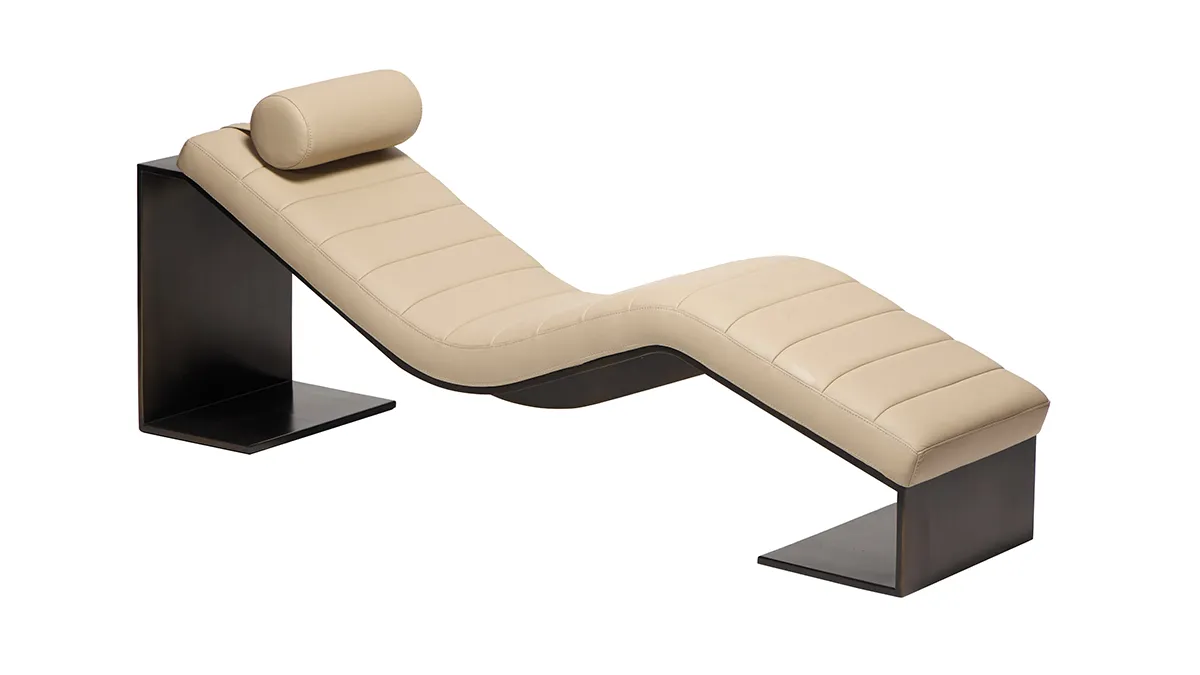
Kimani, Reda Amalou Design
French architect and designer Reda Amalou acknowledges the challenge of creating standout seating given the number of iconic 20th-century examples already in existence. Still, he persists—and prevails. The Kimani, a bent slash of a daybed in a limited edition of eight pieces, makes a forceful statement. Its leather cushion features a rolled headrest and rhythmic channel stitching reminiscent of that found on the seats of ’70s cars; visually, these elements anchor the slender silhouette atop a patinated bronze base with a sure-handed single line. The result: a seamless contour for the body. Around $33,530; RedaAmalou
Dune, Workshop/APD
From a firm known for crafting subtle but luxurious architecture and interiors, Workshop/APD’s debut furniture collection is on point. Among its offerings is the leather-wrapped Dune daybed. With classical and Art Deco influences, its cylindrical bolsters are a tactile celebration, and the peek of the curved satin-brass base makes for a sensual surprise. Associate principal Andrew Kline notes that the daybed adeptly bridges two seating areas in a roomy living space or can sit, bench-style, at the foot of a bed. From $13,040; Workshop/ APD
Sherazade, Edra
Designed by Francesco Binfaré, this sculptural, minimalist daybed—inspired by the rugs used by Eastern civilizations—allows for complete relaxation. Strength combined with comfort is the name of the game here. The Sherazade’s structure is made from light but sturdy honeycomb wood, while next-gen Gellyfoam and synthetic wadding aid repose. True to Edra’s amorphous design codes, it can switch configurations depending on the user’s mood or needs; for example, the accompanying extra pillows—one rectangular and one cylinder shaped— interchange to become armrests or backrests. From $32,900; Edra






